How butterflies and moths “do it”
Text and photographs Steve Woodhall and as credited
Reproduction in butterflies and moths
When I received the brief for this issue of Leopards Echo I was immediately reminded of my favourite newspaper, The Guardian, which has a weekly column titled “This is how we do it”. I’m not going to go into any details but if you have a look at the website you’ll see how varied we humans are in our reproductive techniques. The mechanics of lepidopteran reproduction are quite different, but like ours, the ‘act’ of mating itself is simple. What DOES vary is courtship and parental behaviour.
Why do butterflies and moths exist as flying creatures?
Those who have reared any lepidopteran, like a silkworm, will know that they spend most of their lives as an earthborn organism. Eggs take about two weeks to hatch into caterpillars and the caterpillars, through a series of moults, eat many times their weight in food and grow enormously over a period of weeks or months. Then there is the pupal or chrysalis stage which can also last weeks or months.
The adult stage can be very short, a matter of days or weeks. Lepidoptera aren’t the only insects whose adult existence is a relatively short fraction of their total lifespan. Some species of Cicada spend years as nymphs living underground before emerging as adults for a short time before dying. Mayflies live underwater as larvae for months before emerging at the surface for a 24-hour adult existence.
Adult insects have few, very basic, objectives:
1. Emerge successfully from the pupa
2. Take to the skies
3. Get fuel on board
4. Avoid getting eaten
5. Find a mate
6. Have sex
7. (Ladies only) find the right food for her young
8. (also, Ladies only) lay her eggs
I liken the adult stage of insects to the flowering stage of plants. Most of a plant’s lifespan is taken up with vegetative growth. Production of flowers, the reproductive stage, is relatively short and energy intensive. In annual plants once the flowers have been fertilised and have set seed, that’s it! All insects, including butterflies and moths, are the same. Once the job is done, they can be food for predators – of which there are many, because they are at the bottom of the food chain…
We have lift off!
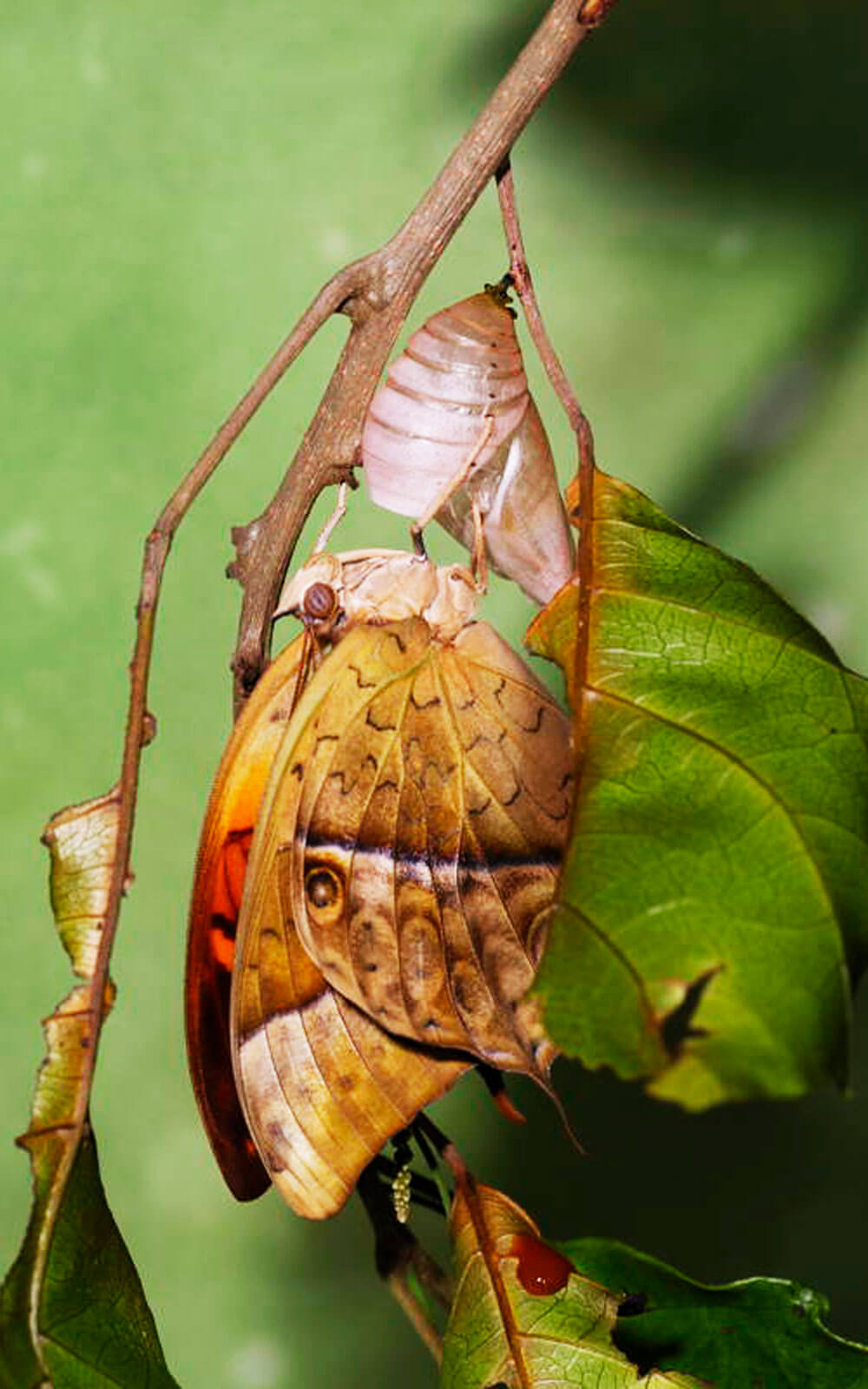
A familiar local butterfly, the Pearl Emperor or Charaxes, having just emerged from its chrysalis. Its wings are expanded but still soft.
Getting out of the chrysalis is the first battle the new adult butterfly has to face. The wings are packed tight into the pupal case like an unopened parachute. The newly emerged adult has to expand them by pumping fluid into the wing veins. Whilst this is happening the wings are soft and deform easily, but the clock is ticking! Once the process has begun the material the body is made of (chitin) begins to harden and within an hour or so it’s cured like an epoxy adhesive. If anything – a leaf, a twig, obstructs this process the wings may be permanently deformed. That can cripple the butterfly and prevent it from feeding and mating.
Once a butterfly can fly it can search for food and mates – vital to its reproduction.
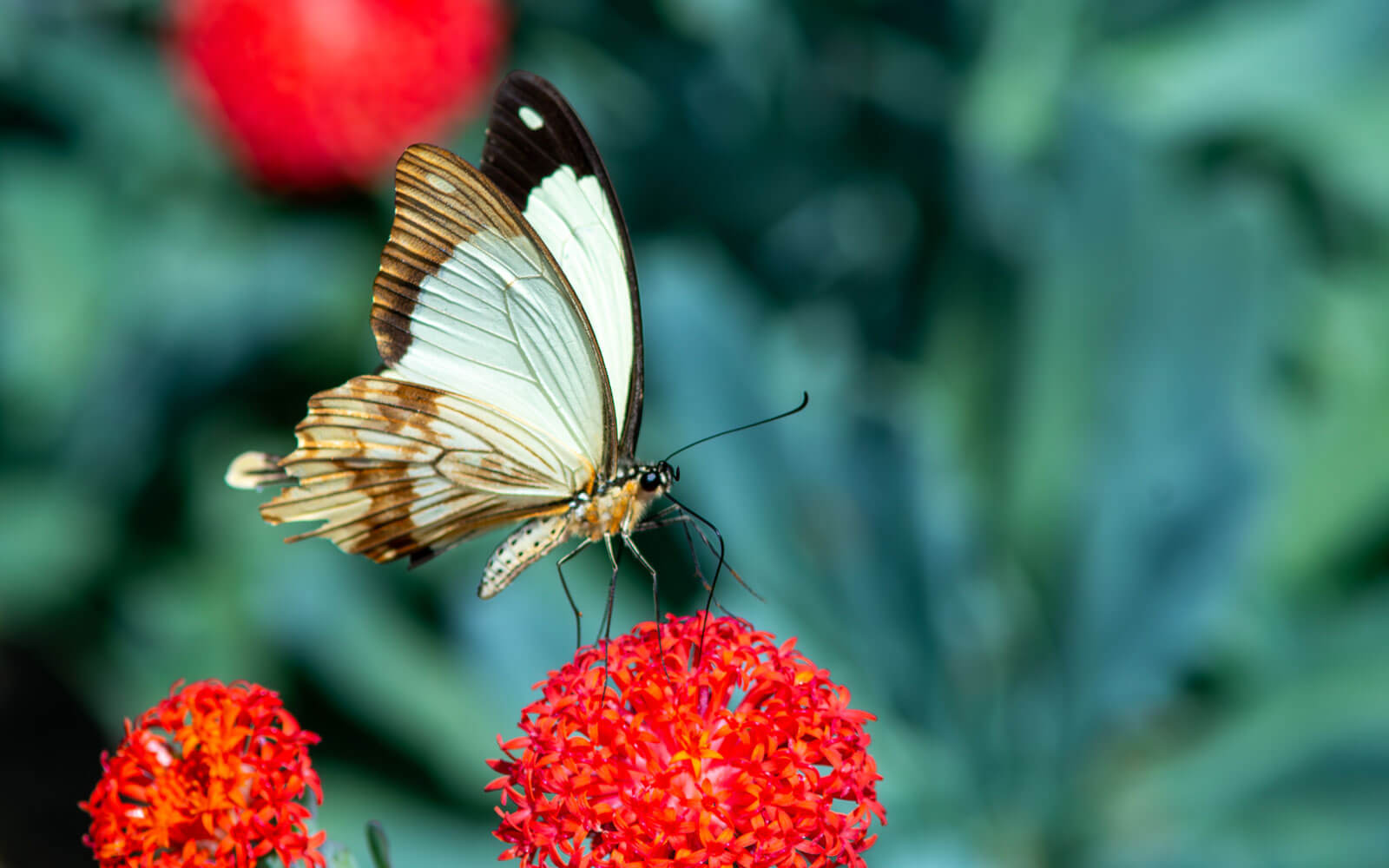
Male Mocker Swallowtail feeding in flight on Coral Senecio
Swallowtails are the quintessential flying feeding machines. Many butterflies settle on flowers to suck nectar, but this Mocker Swallowtail male is doing a bit of mid-air refuelling. This was photographed during the 2021 Open Gardens weekend. In a previous LE I wrote about these butterflies being attracted to red flowers.
Avoiding getting eaten
Butterflies and moths have many predator avoidance strategies. There’s not much point in spending months as a caterpillar and a chrysalis only to get eaten before you can mate!
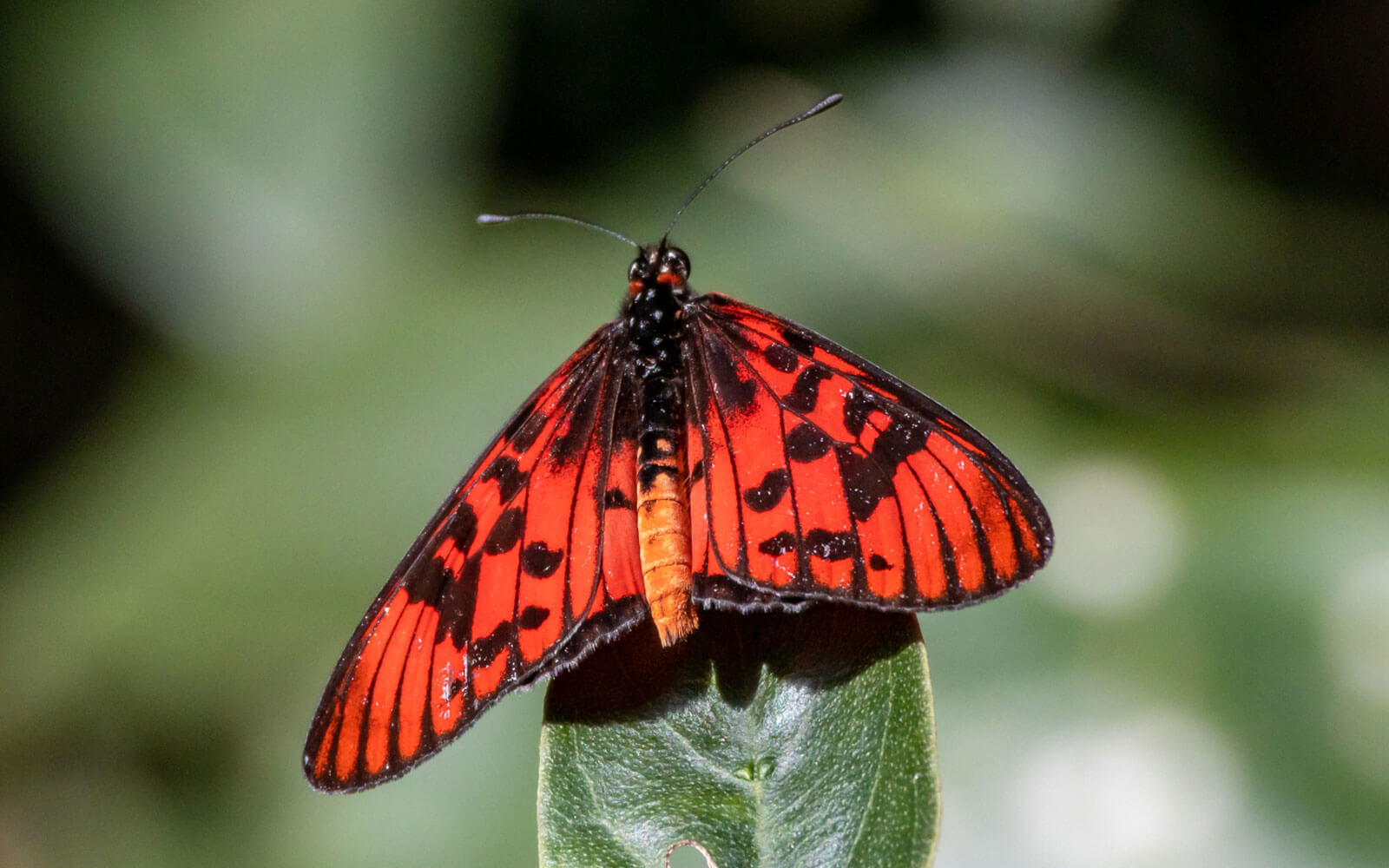
A male Blood-red Acraea, Rubraea petraea, showing his vibrant red colouring. Red is the colour of danger to many predators, and this one is advertising that anything that tries to eat him will regret it.
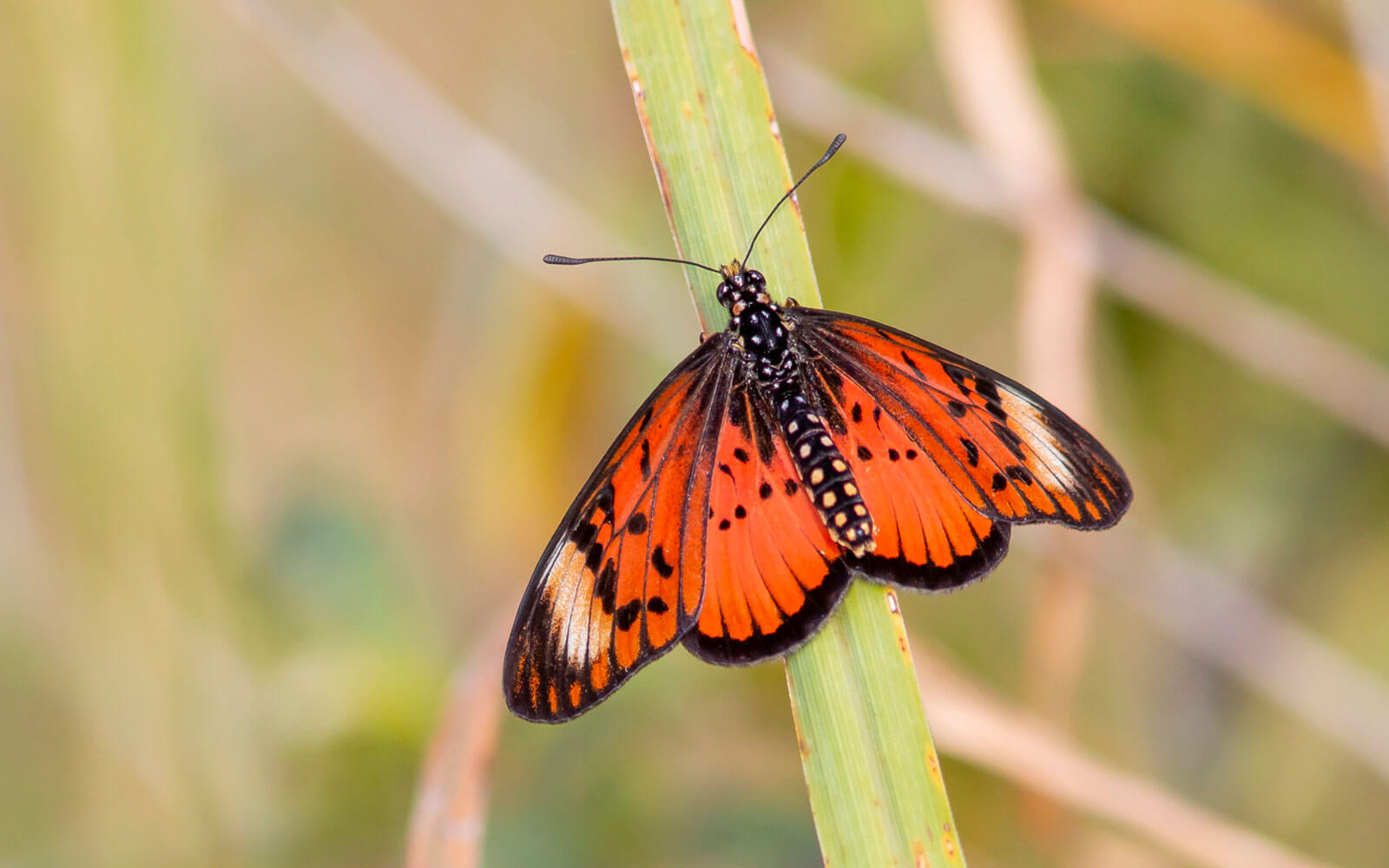
A female Blood-red Acraea, Rubraea petraea, showing the white forewing patch that distinguishes her from a male. She still has the red warning colouration but the difference in wing pattern allows mate recognition – another important factor in butterfly reproduction.
There are many other predator avoidance methods besides colours and patterns. However, this article is about reproduction strategies, so I’ll concentrate on those.
Finding a mate – courtship
Visual cues
Many butterflies and diurnal moths rely on simple visual cues like the one described above for the Blood-red Acraea. Sexual dimorphism is common and works because these insects have good pattern recognition and colour vision too. Sometimes the dimorphism is driven by different survival needs of males and females.
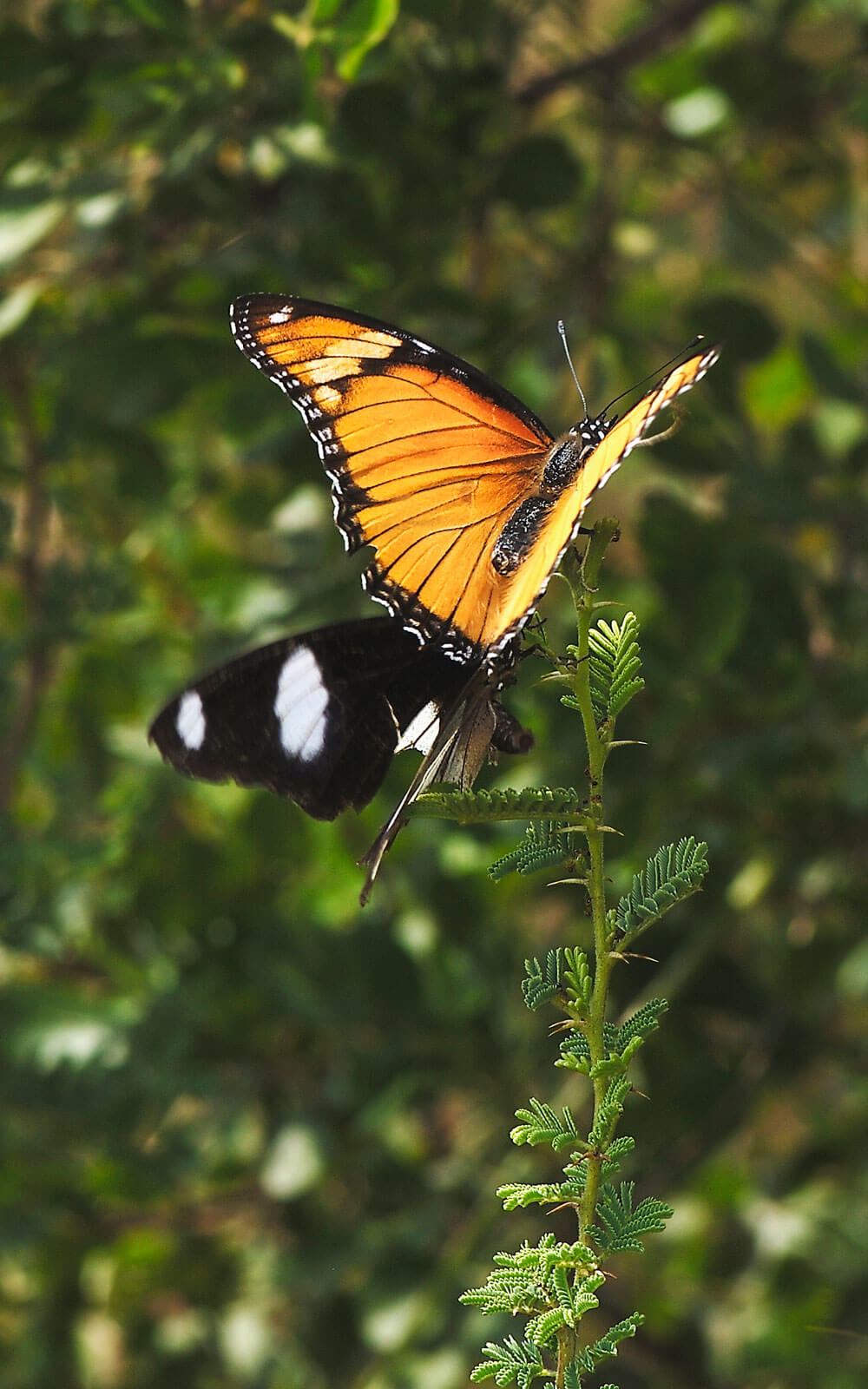
A female Common Diadem Hypolimnas misippus being attended from below by a male
Many of the Diadem genus Hypolimnas have similarly marked males and females with black-and-white wings. The Common Diadem is distinct in that the female looks like an African Plain Tiger, Danaus chrysippus. This has probably more to do with the female gaining protection from resembling a toxic, distasteful species than it has to do with mate recognition.
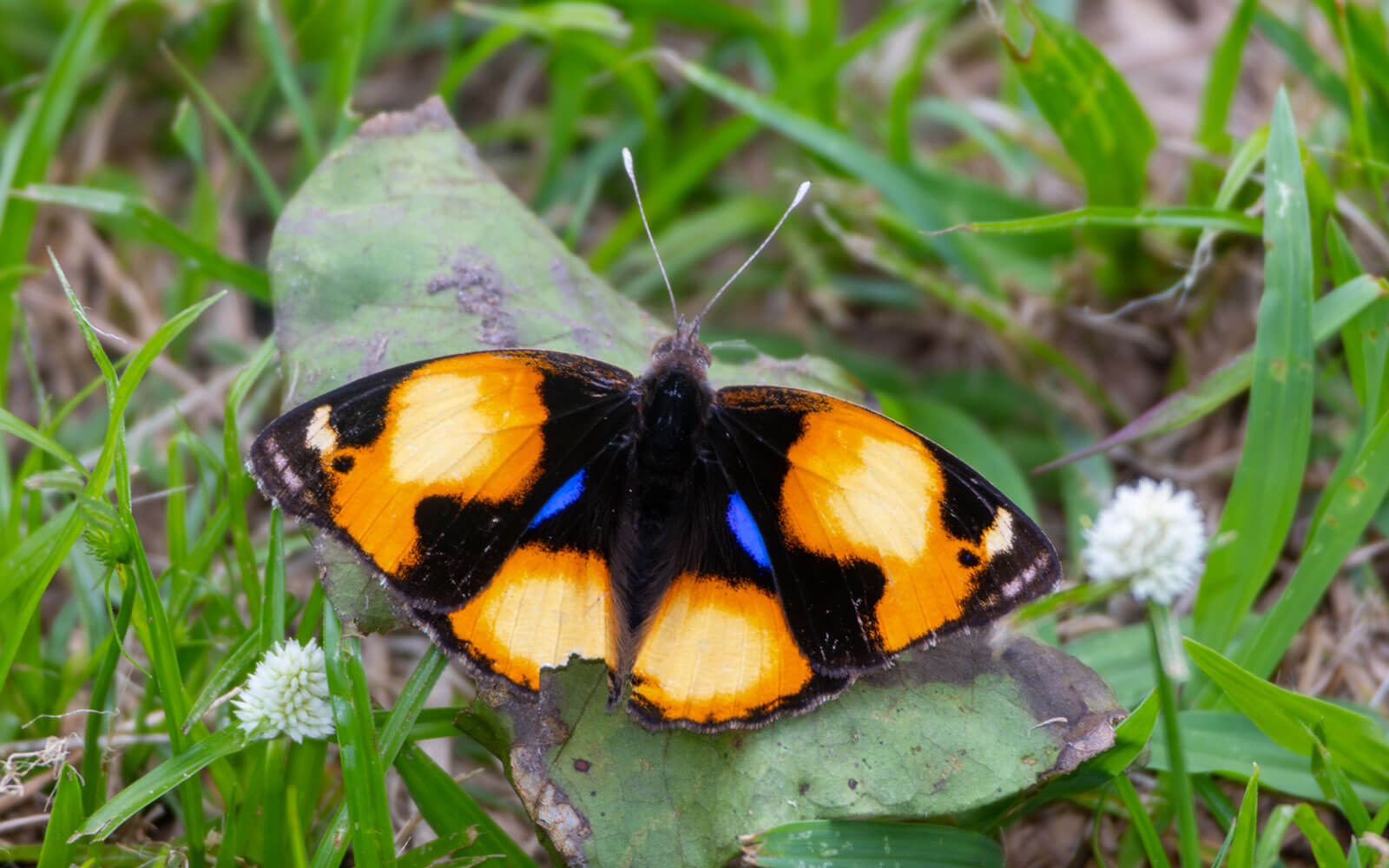
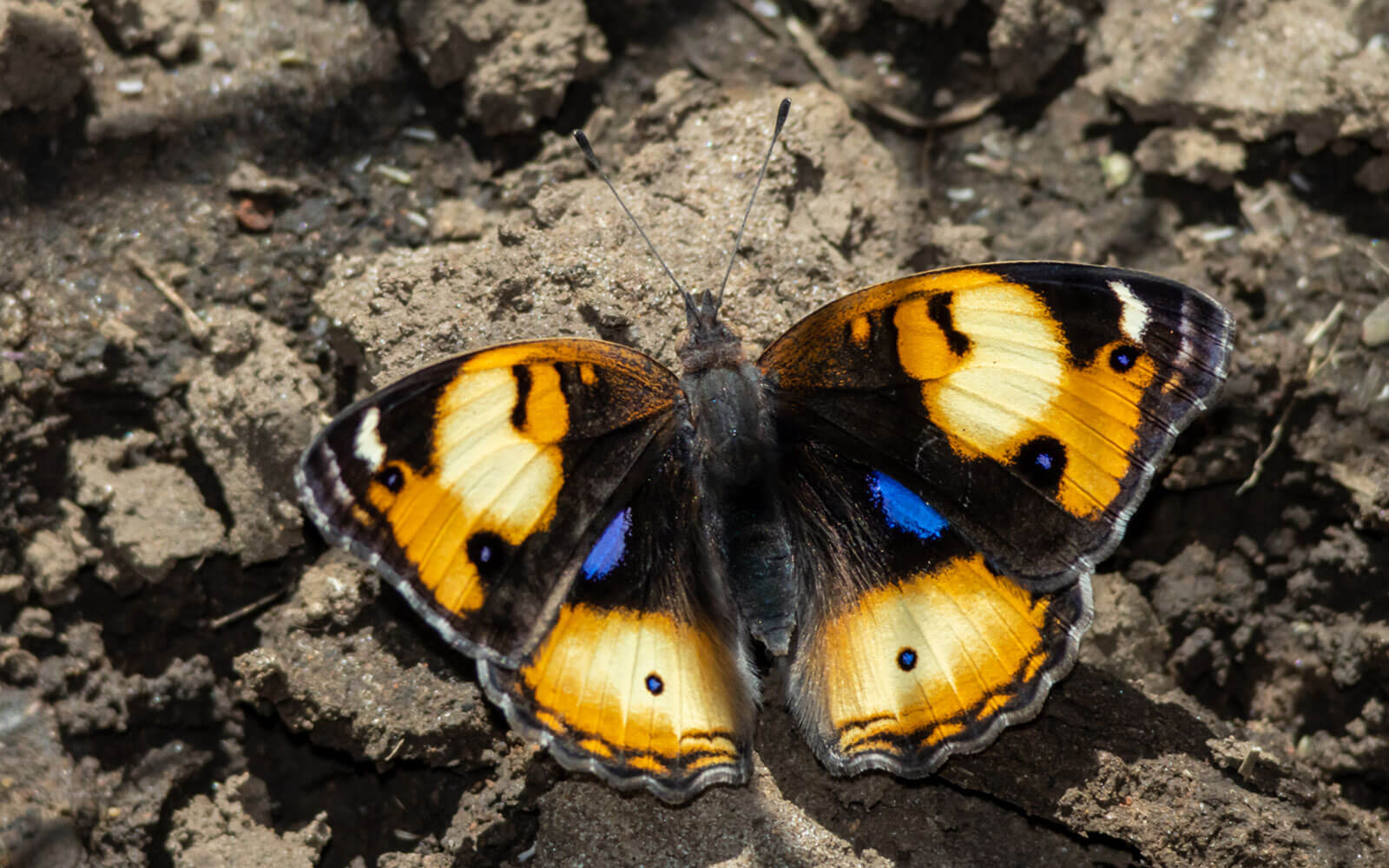
The common African Yellow Pansy, Junonia hierta cebrene, has subtle differences in upperside wing markings between males and females.
In many sexually dimorphic butterflies like the African Yellow Pansy the differences may be subtle, but they exist. In other species the female may have more or larger eyespots on the wings or the wing pattern could be very different, as in the Common Zebra Blue Leptotes pirithous.
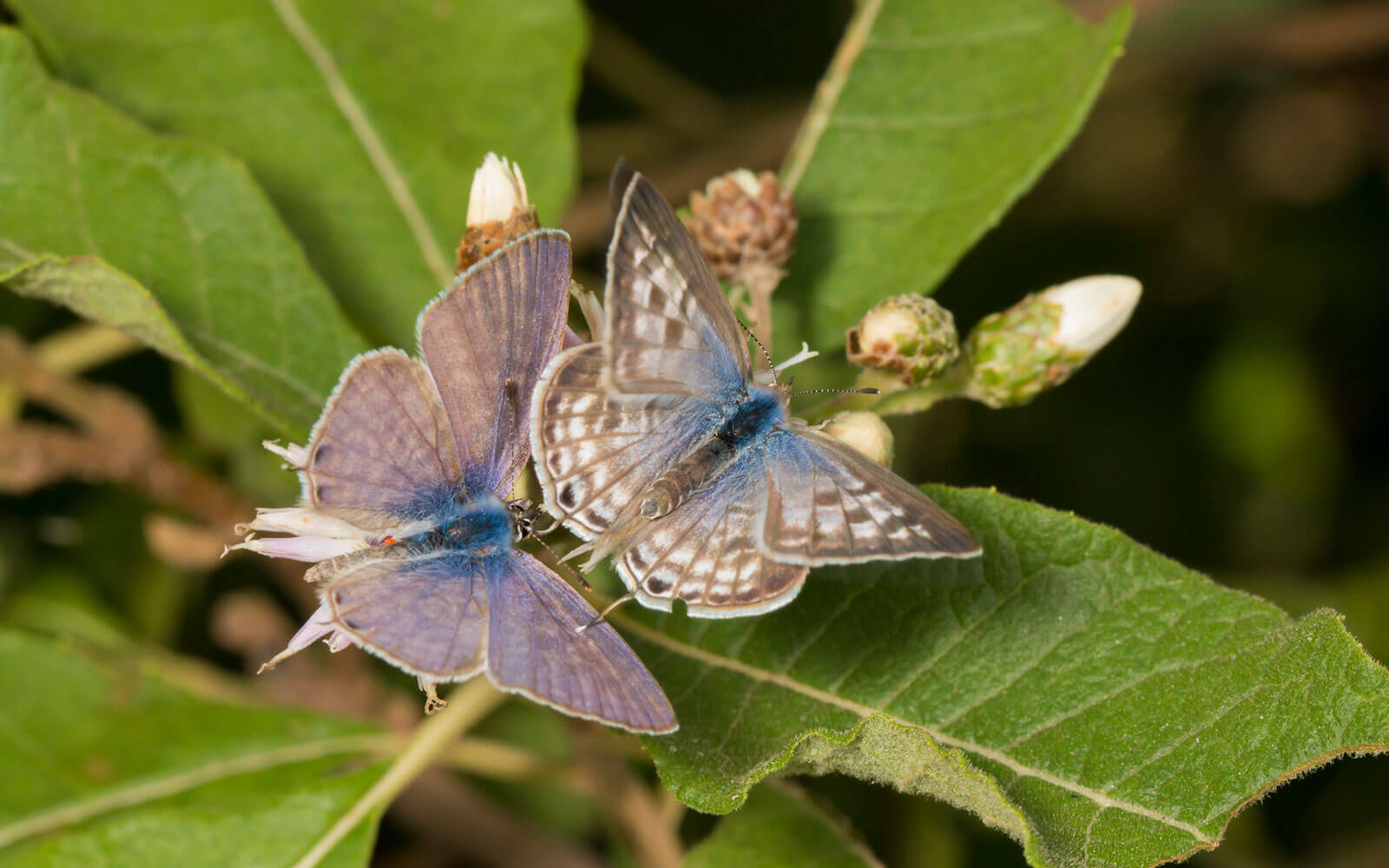
A pair of Common Zebra Blues, preparing to mate
Non-visual cues
Because most lepidoptera are nocturnal many of them can’t rely on visual cues to recognise a potential mate. The majority of these non-visual cues rely on scent. This is the case for many butterflies as well, even diurnal ones. They have specially purposed scales and hairs that give off pheromones, which are chemicals resembling hormones that can affect the behaviour of a member of the same species. Sometimes glands release hormones that have the same effect and are spread around purposely by the animal emitting them.
They may work in conjunction with visual cues that are more long-range than the pheromones which work at close quarters. Such mixing of cues is an important aspect of the courtship rituals that many species undergo before they mate. These are like a formal dance that has to happen in a certain order before mating is possible. If one element is missing, they may fail to mate.
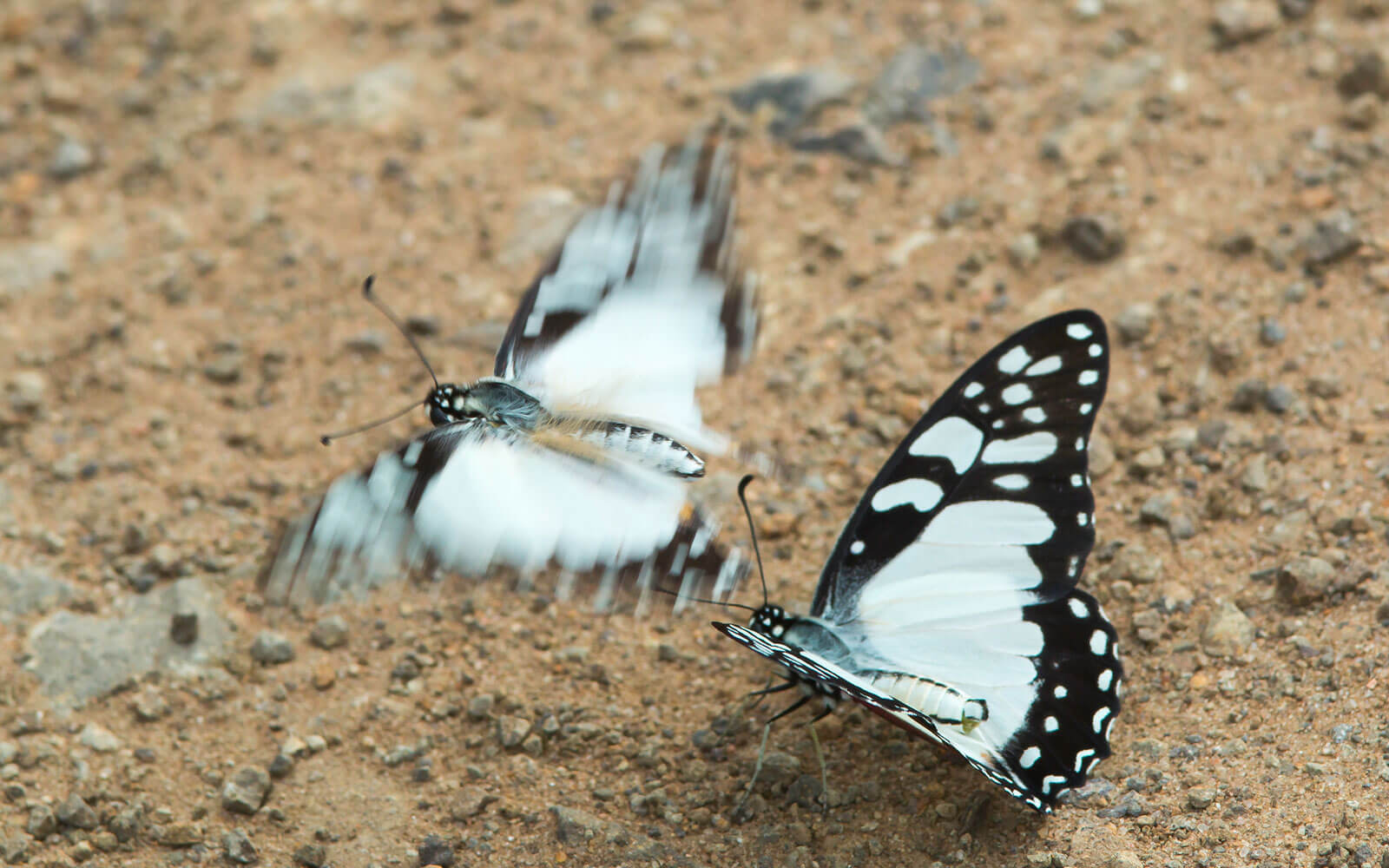
The male White Lady, Graphium morania, to the left, erecting his hair pencils in the presence of a female
This male White Lady (or White Lady Swordtail) has encountered a female, probably as part of a courtship flight. He is rapidly quivering his wings and a fold on the inner margin (nearest his abdomen) has opened up to expose his yellowish hair pencils. These are releasing and scattering a pheromone that is making the female receptive to mating. This is evident from the appearance of the tip of her abdomen.
These hair pencils are the reason for the Swordtail genus having the scientific name Graphium, which comes from the Greek word for a writing stylus. Graphite, used in the pencils we use to write, has the same word root.
Many butterflies and moths use such methods to attract and excite mates.
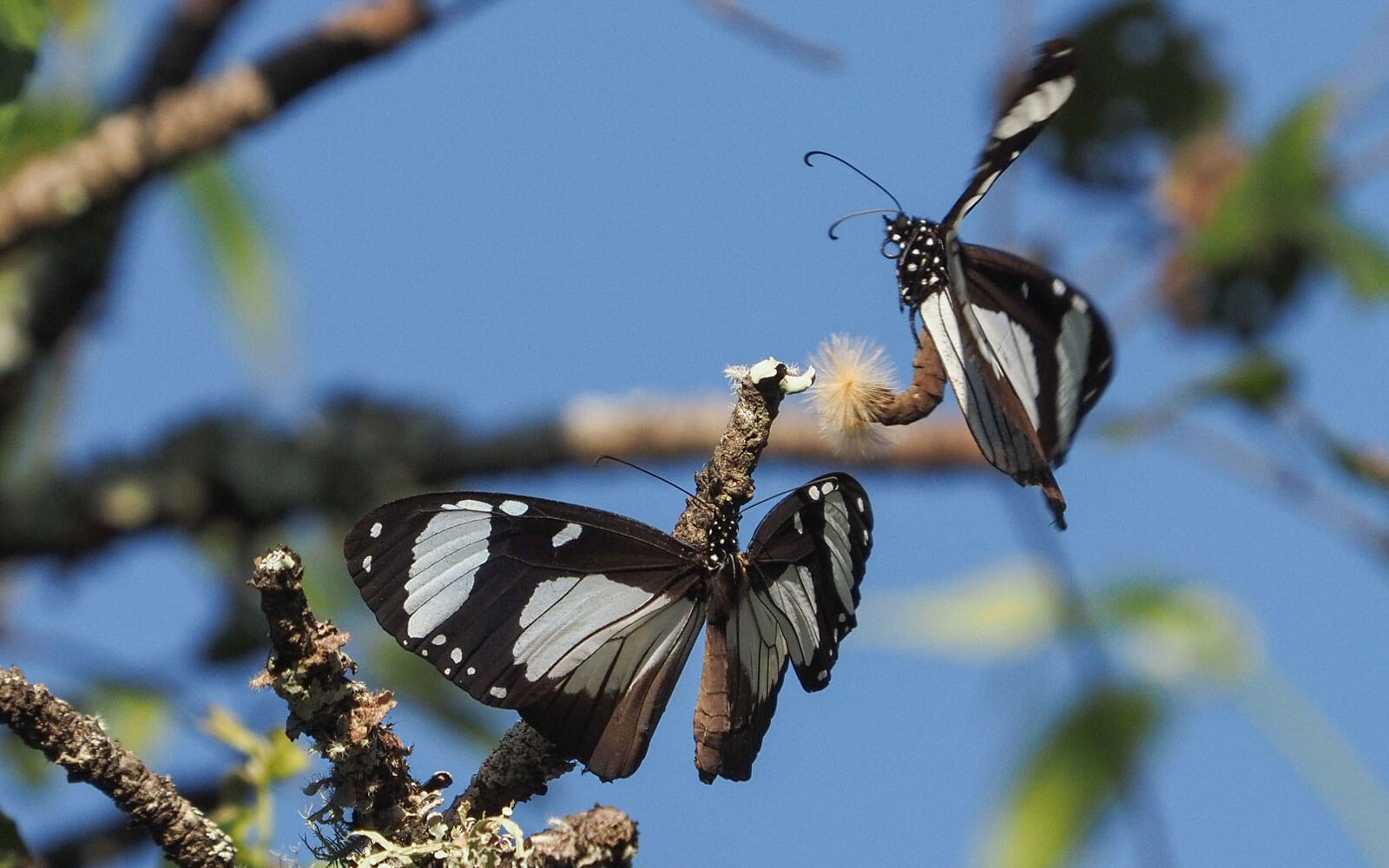
Males of the genus Amauris (or Clerics) provide another example of the use of hair pencils. The male Southern Friar, Amauris niavius, has extruded hair pencils concealed in the tip of his abdomen, which he uses to scatter pheromones over the female. His hindwings have patches of specialised pheromone-carrying scales that he uses the hair pencils to dust the female with, initiating mating. This process is very rapid, and this photograph was captured by Callan Cohen.
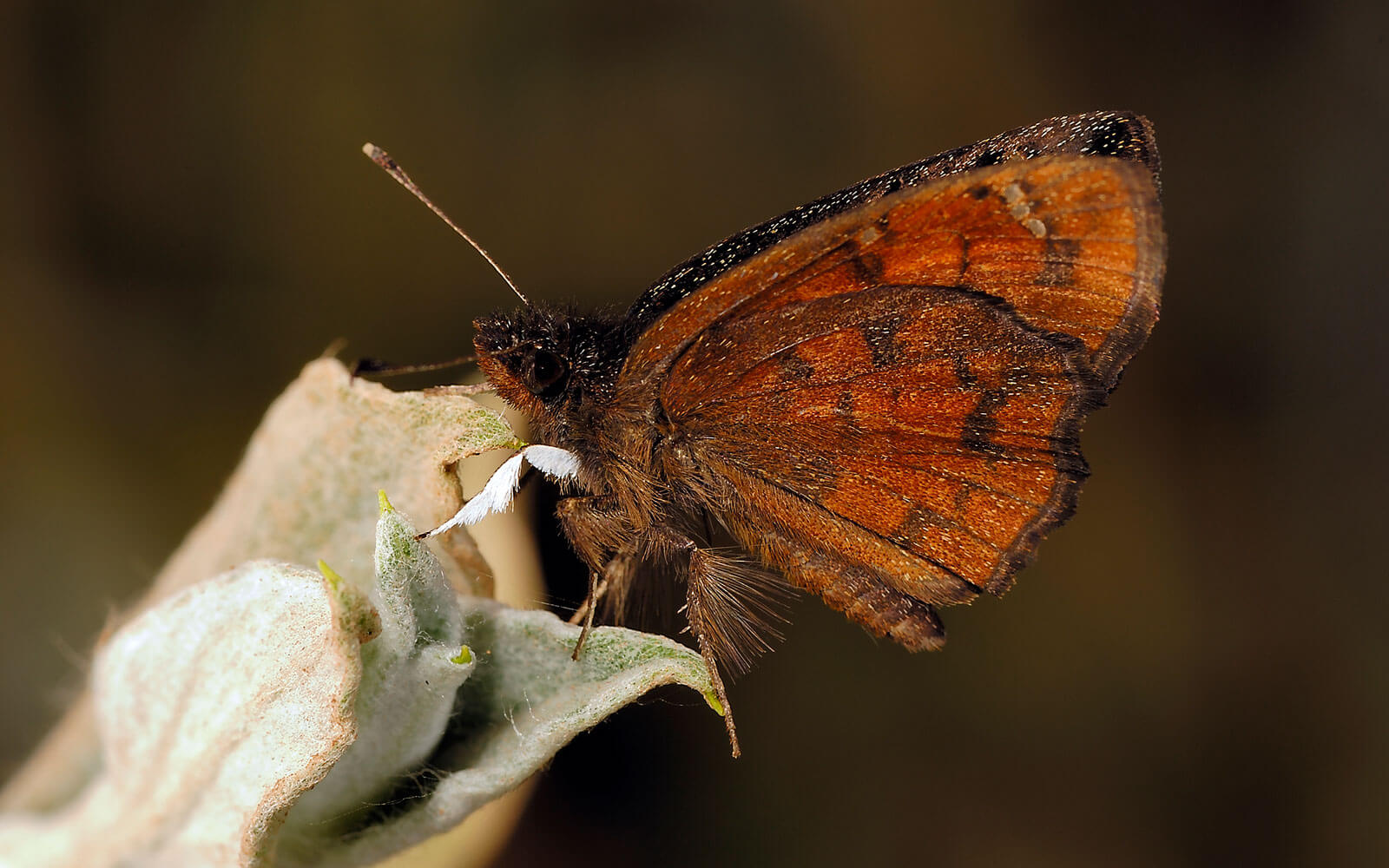
Marbled Elf Eretis djaelaelae exposing hair pencils on his legs
Many ‘Skipper’ butterflies like this Marbled Elf, Eretis djaelaelae, perch in exposed places where their pheromones can be carried by the wind to attract females. Such use of pheromones is best known in the Emperor and Atlas Moths of the Saturniidae, but in those it is the females that use them to attract males – a practice known as ‘assembling’.
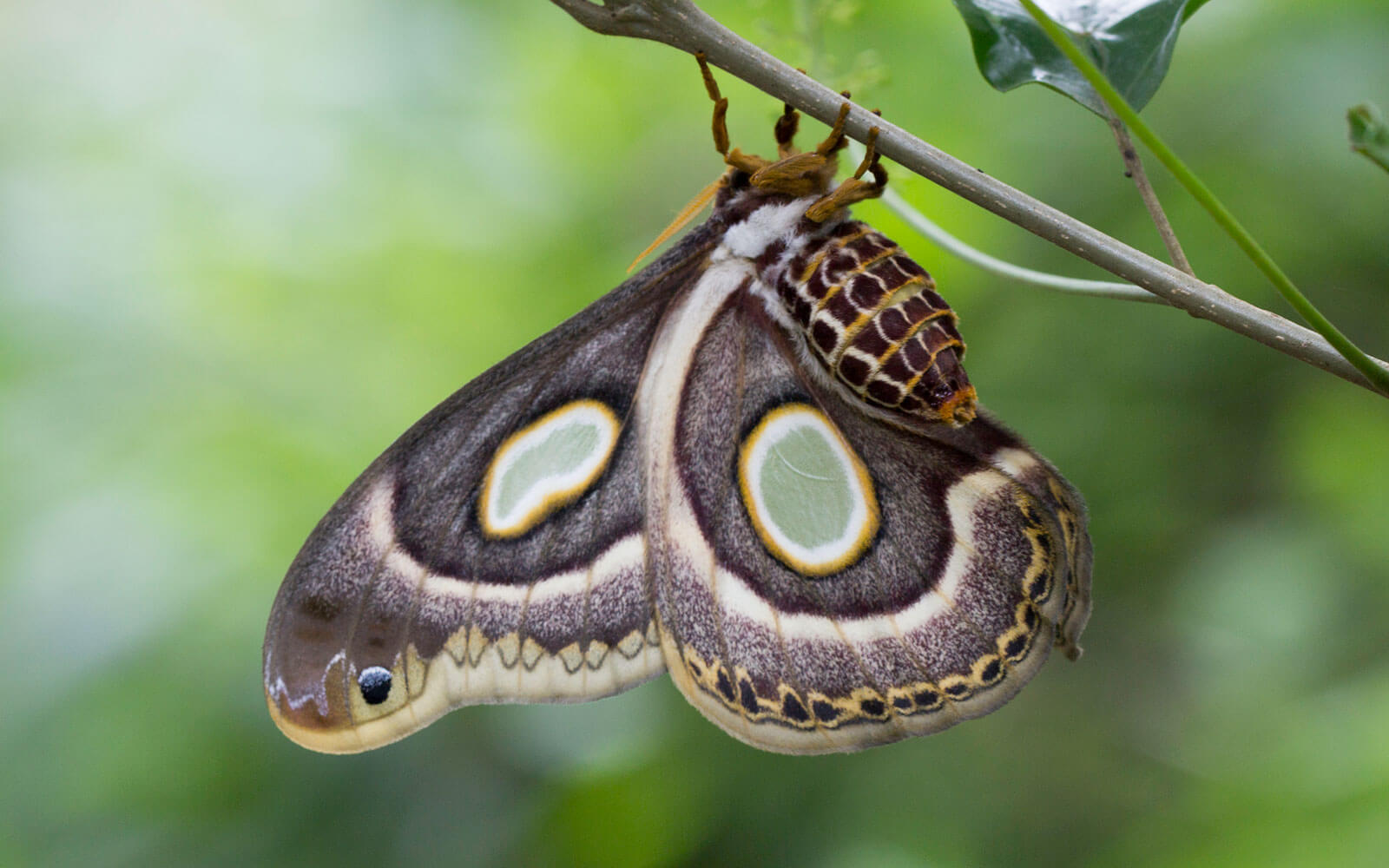
Female White-ringed Atlas moth Epiphora mythimnia ‘assembling”
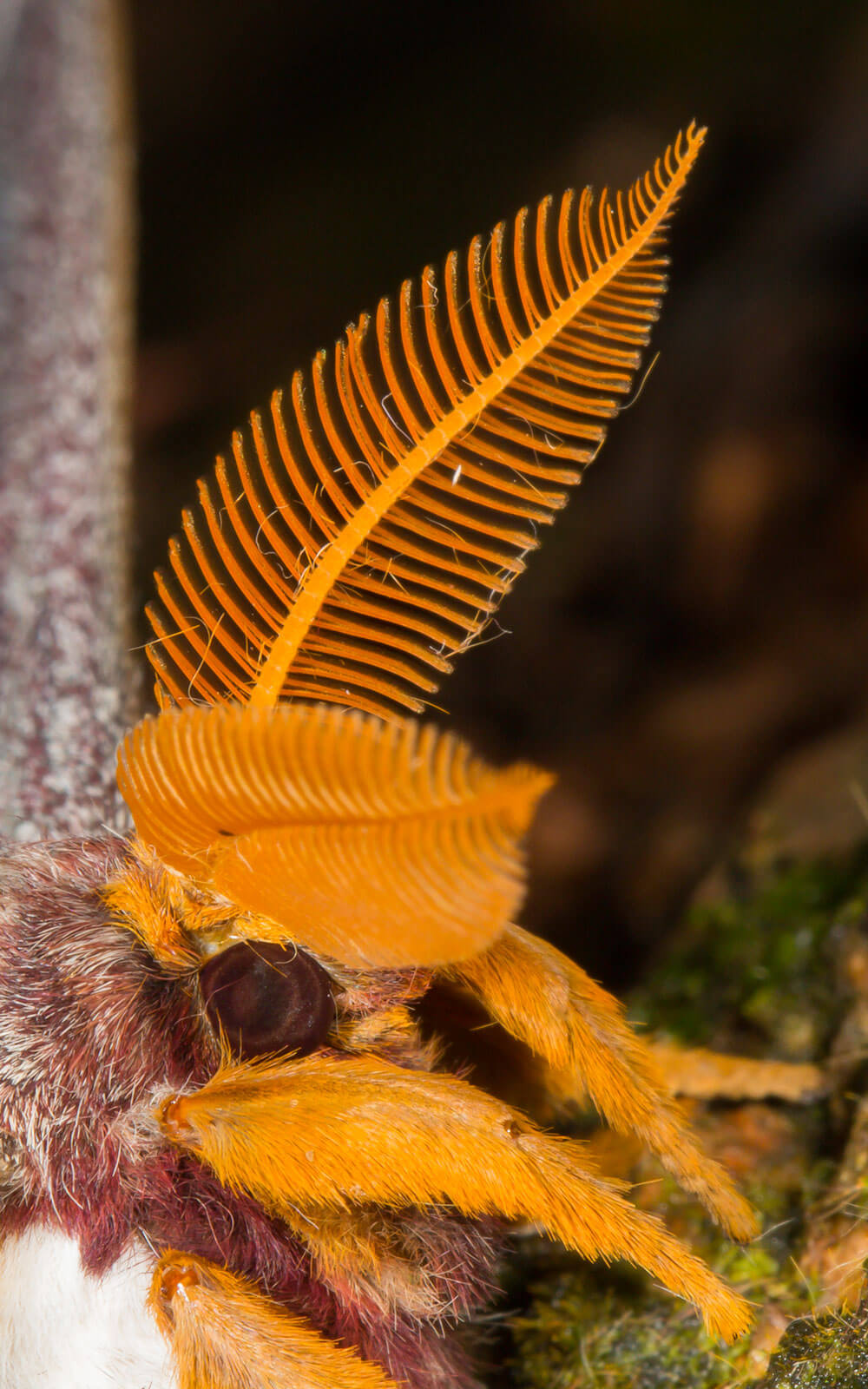
Detail of pheromone-detecting antennae of male White-ringed Atlas moth Epiphora mythimnia
The female Atlas moth has a huge abdomen packed with eggs. Her only purpose is to attract a male and lay her eggs. She cannot feed – her mouthparts are vestigial. Her antennae are slender and she’s hanging from a branch, emitting pheromones from an organ on the tip of her abdomen.
The male has a slenderer abdomen, but the main difference to the female is his relatively huge antennae. With these he can detect the female’s pheromones from up to a kilometre away and reliably fly to her and mate with her.
Sometimes the pheromones are carried by patches of scent scales on the male’s wings and are easily visible to the naked eye.
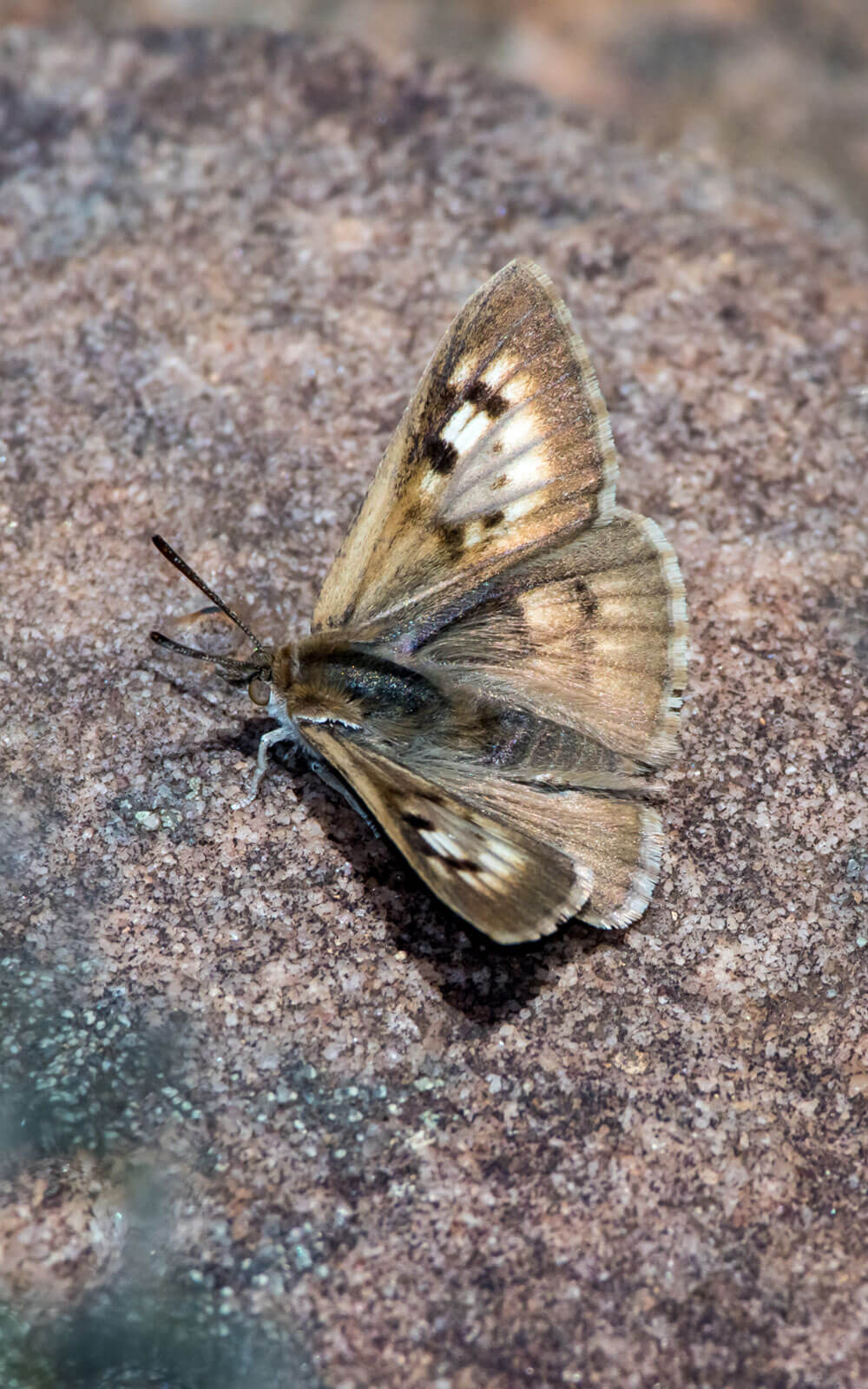
Basuto Skolly Thestor basuta male sunning himself on the hilltop at Monteseel
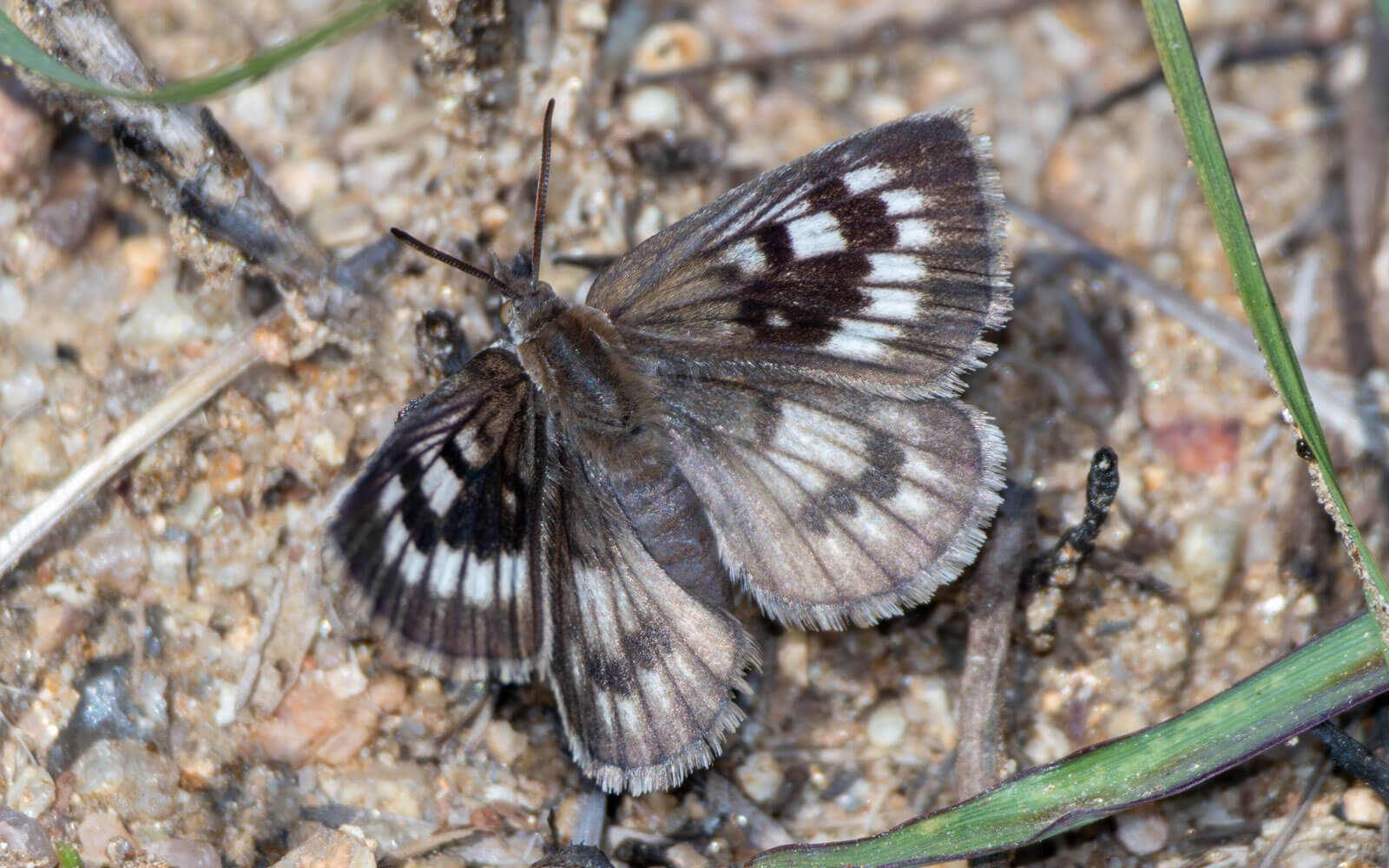
Basuto Skolly Thestor basuta female sitting on bare earth at Monteseel
The male Basuto Skolly carries a triangular patch of pale grey scaling in the middle of his forewing. He will fly to and fro across the grassy habitat, scattering pheromones as he goes. The more conspicuously marked females, if virgin and receptive, pop up and a courtship flight ensues followed by mating. This species has one of the weirdest reproduction strategies in the world of butterflies and it isn’t difficult to find in the Kloof area.
Mate location
As we showed earlier, many butterflies and moths use pheromones to attract mates. But like birds and mammals they also have ways of physically locating the opposite sex.
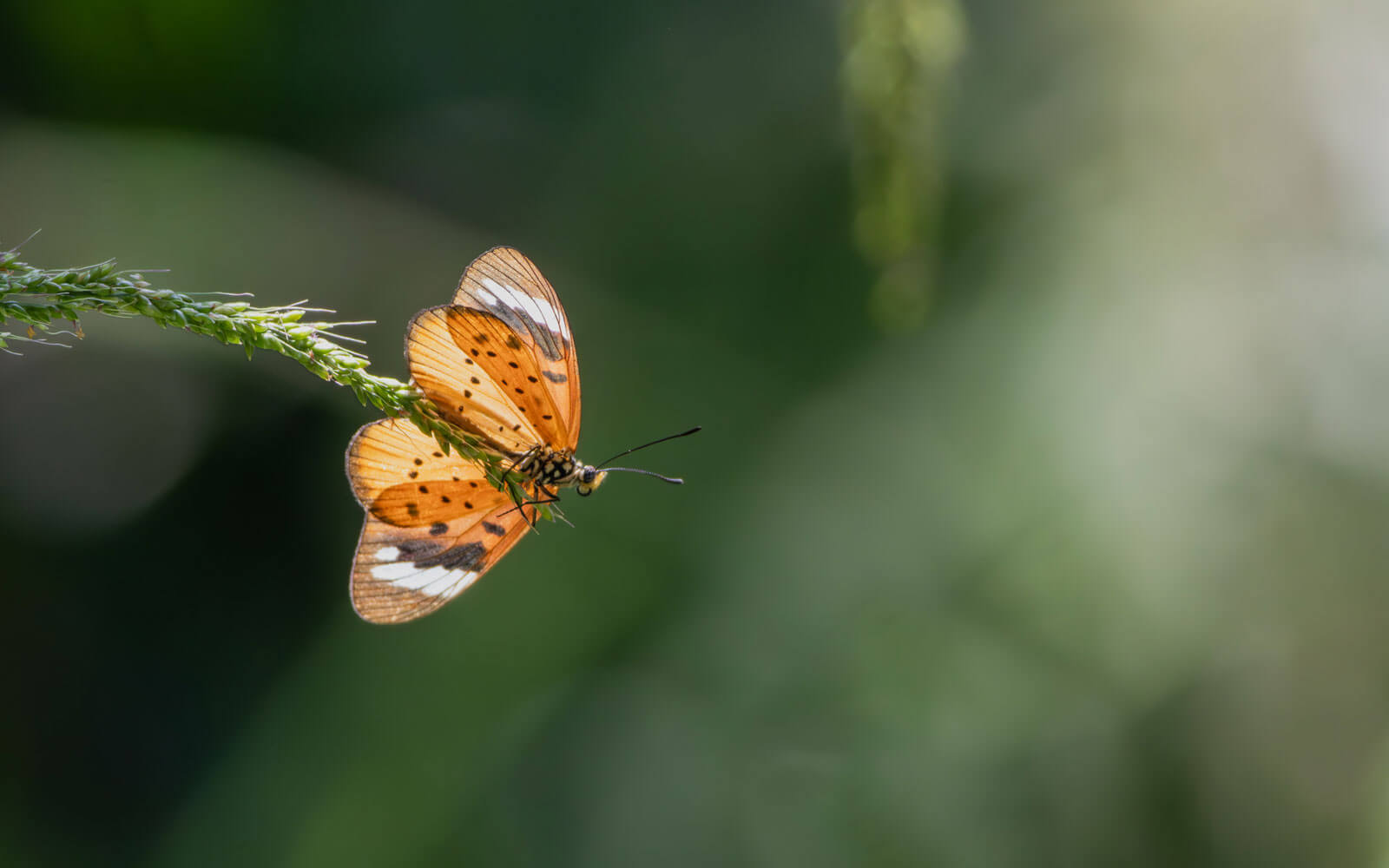
Male White-barred Telchinia Telchinia encedon adopting a high perch from which to watch for females flying below
Some males choose a perch on a branch or twig above a patch of host plant or nectaring flowers. They lurk there waiting for a female to come into view, like this White-barred Telchinia is doing. Most of the time they do this singly but there are some places where several males choose a territorial perch and chase off all potential rivals before choosing a mate.
‘Lekking’ is a term used to describe the way male animals congregate in a place to display to females. Male butterflies usually choose a high point like a tall tree, a rock, or a hilltop, and perch there. Usually, you can see several individuals of different species in these ‘leks’.
There are several such spots in the Kloof area: Nkonka Trust has a well-used hilltop. Rosemarie Avenue at Monteseel has a great hilltop butterflying spot. Inside Krantzkloof Nature Reserve there is the sharp hilltop near the path to the well-known rock-climbing spot at Rumdoodle. A few hours spent at one of these can yield dozens of great butterfly sightings as well as mating behaviours.
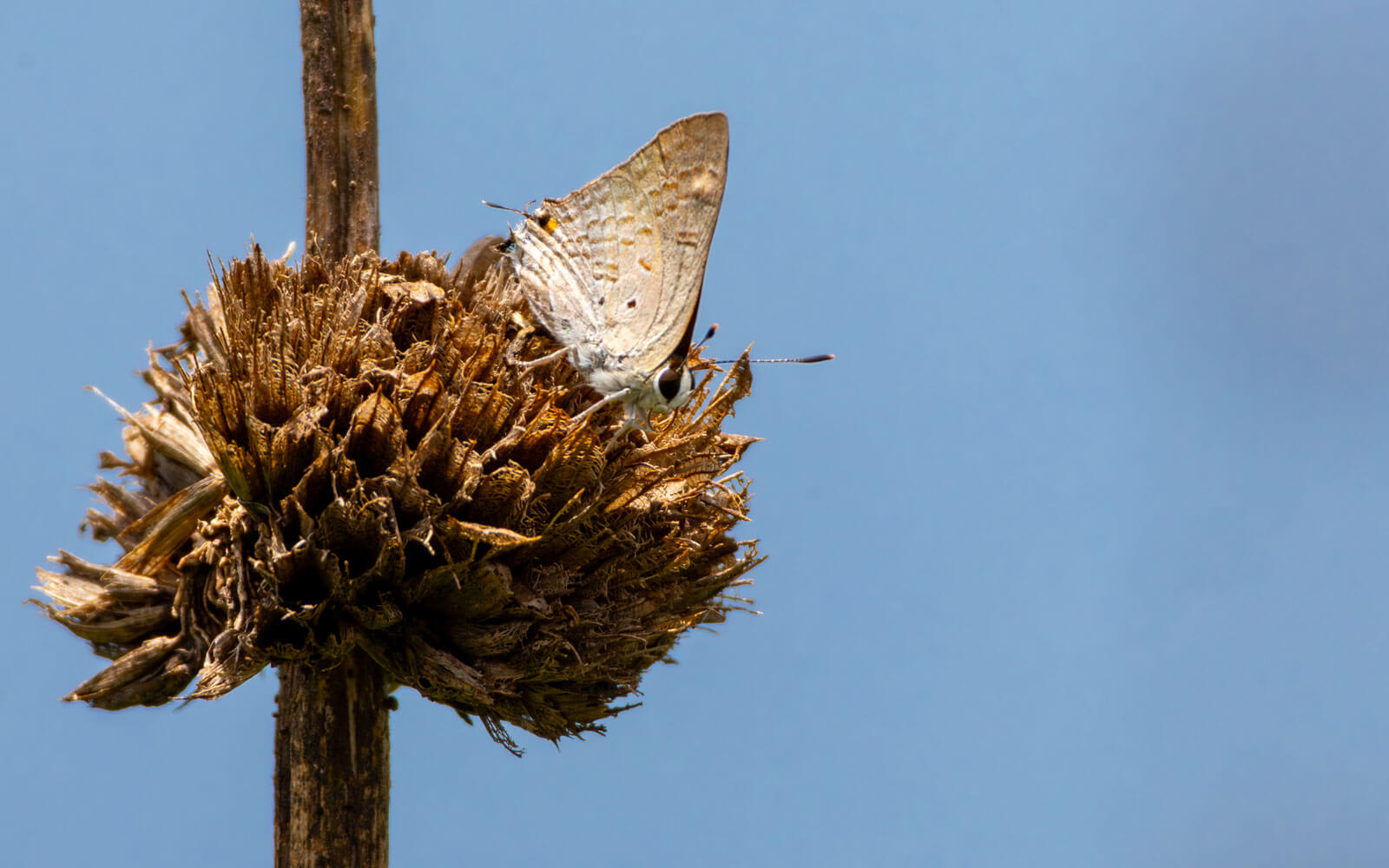
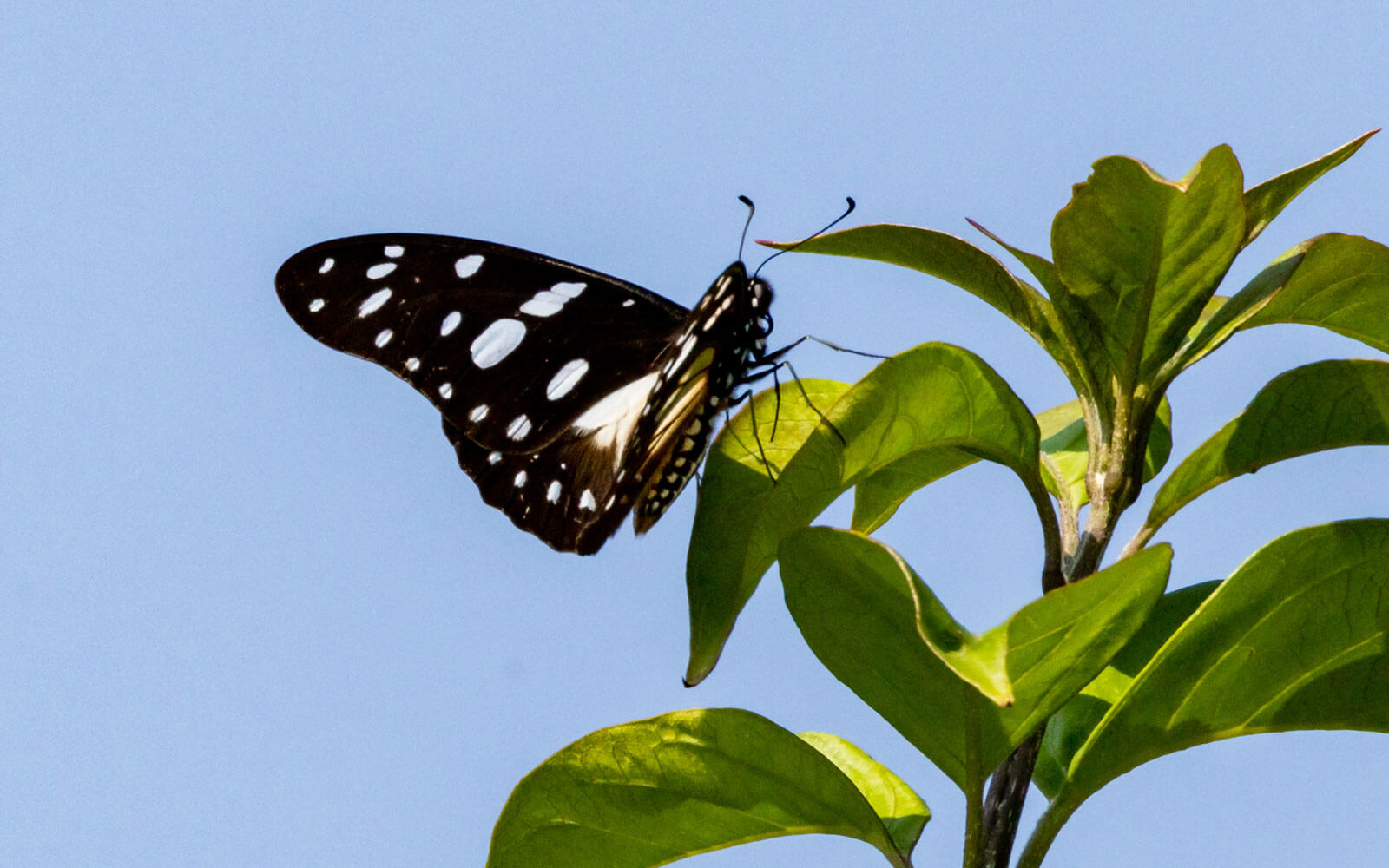
A male Veined Swordtail Graphium leonidas atop the bushes on the Rumdoodle hilltop
Males sit alertly on such vantage points and chase away any intruders of their own or other species. Playboys and Veined Swordtails are avid ‘hilltoppers’ but many other butterflies do this – Sapphires, Paradise Skippers, Charaxes, Citrus Swallowtails…
Copulation – ‘doing it’
Sometimes the female isn’t receptive to the male’s advances and rejects him.
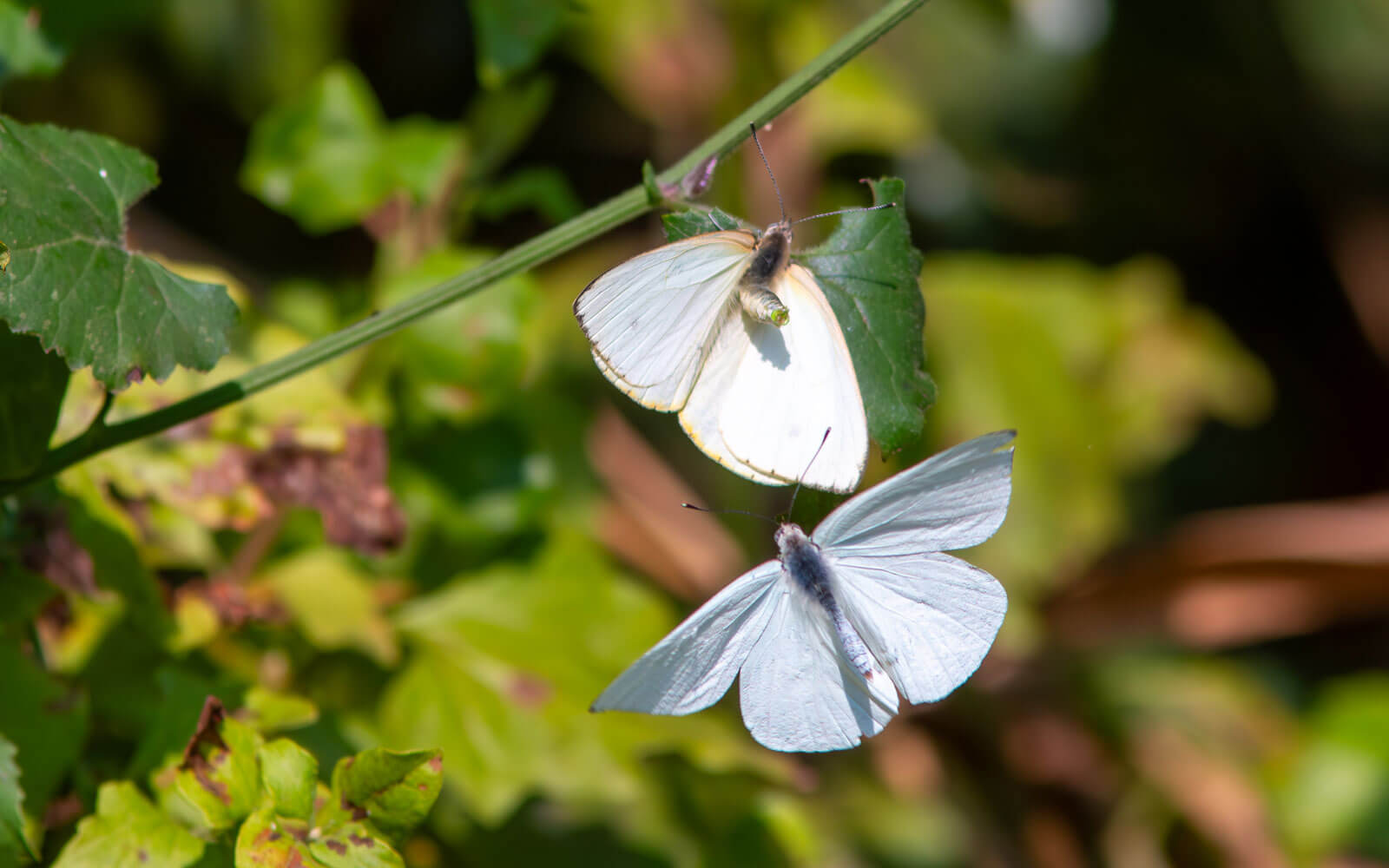
Small Ant-heap White Dixeia pigea female rejecting a hovering male by raising her abdomen
This male Small Ant-heap White Dixeia pigea can be distinguished from the female by his bluish-white colour and lack of forewing spots. Some of these all-white butterflies carry bold wing patterns only visible in UV light. We cannot see them, but they can because their vision ranges into the ultraviolet. The female’s raising of the abdomen seems to be a common mate rejection feature of all this group of butterflies, the Pieridae. Females that have already mated refuse further matings with other males.
Once the butterflies have concluded their courtship rituals the female usually sits still and allows the male to sidle up to her and clamp his genitalia onto hers.
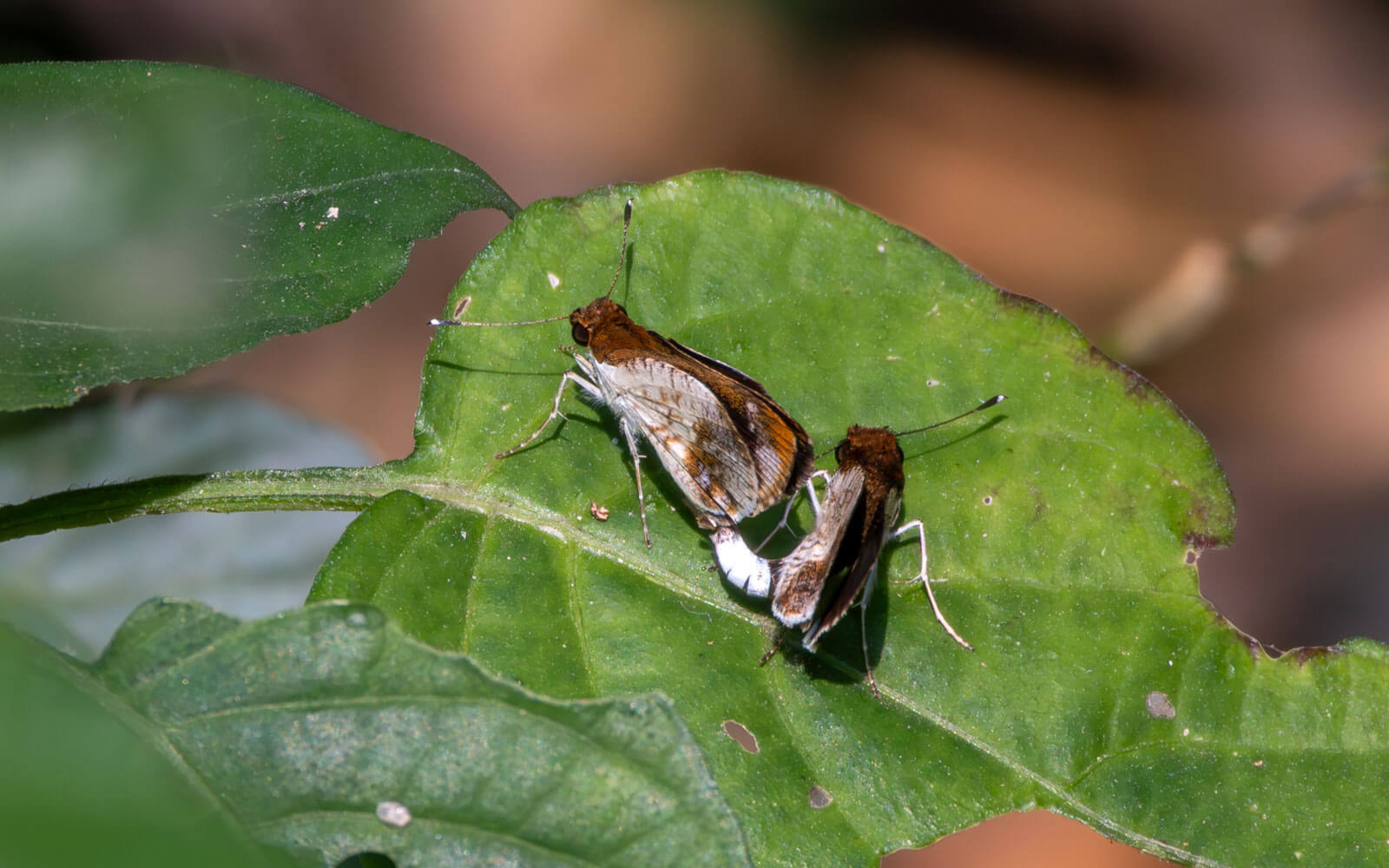
A male Macken’s Dart, Acleros mackenii, getting in position to mate with the female
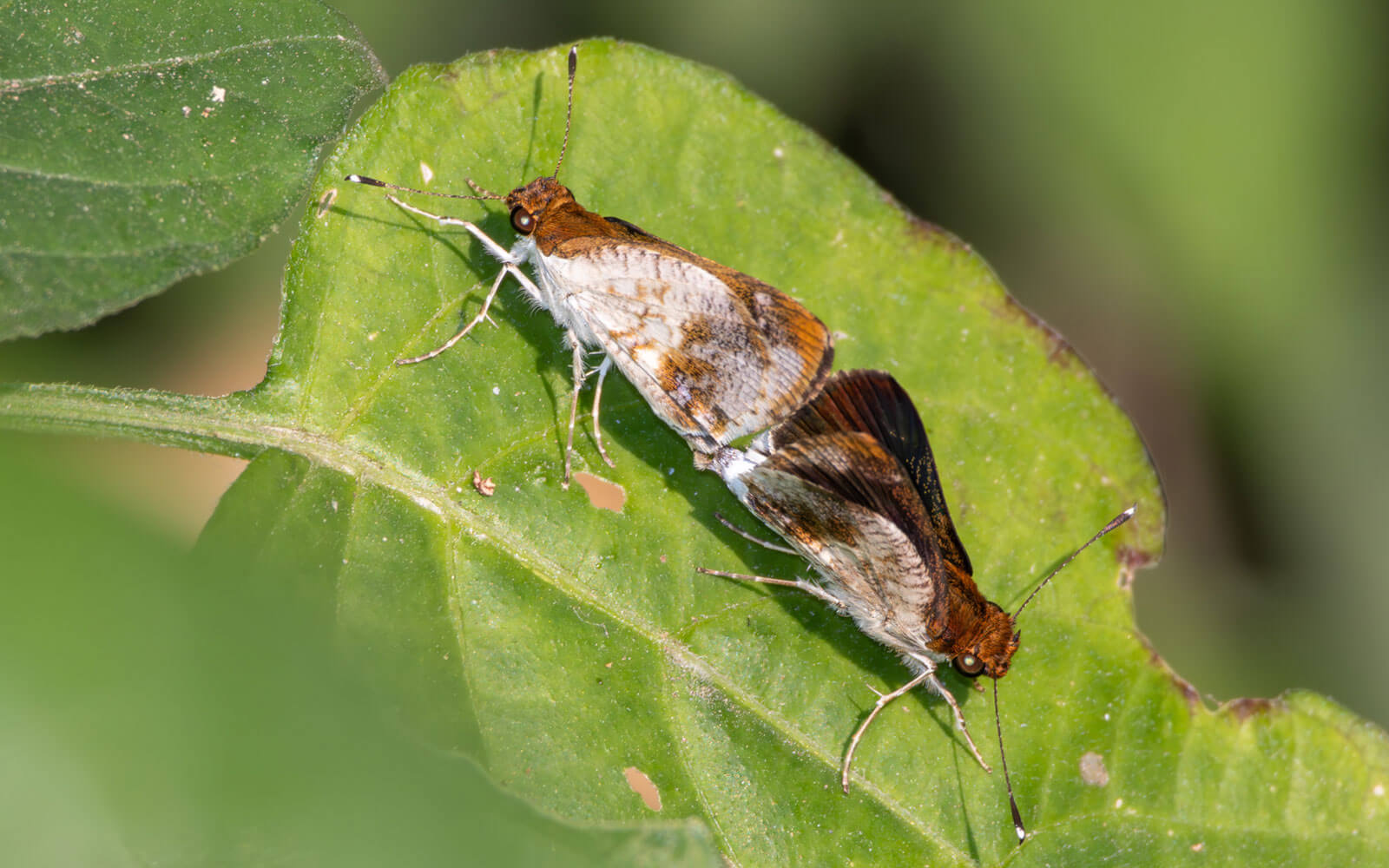
A pair of Macken’s Darts, Acleros mackenii, in the normal tail to tail mating position
The male Macken’s Dart has calmed the female down to the point where he can curve his abdomen around and latch onto the female. Once he has done this they will move around to the ‘tail to tail’ mating posture butterfly watchers are familiar with. They may stay in this position for a few minutes to several hours – it is known as being ‘in copula’.
Sometimes it gets a bit messy…
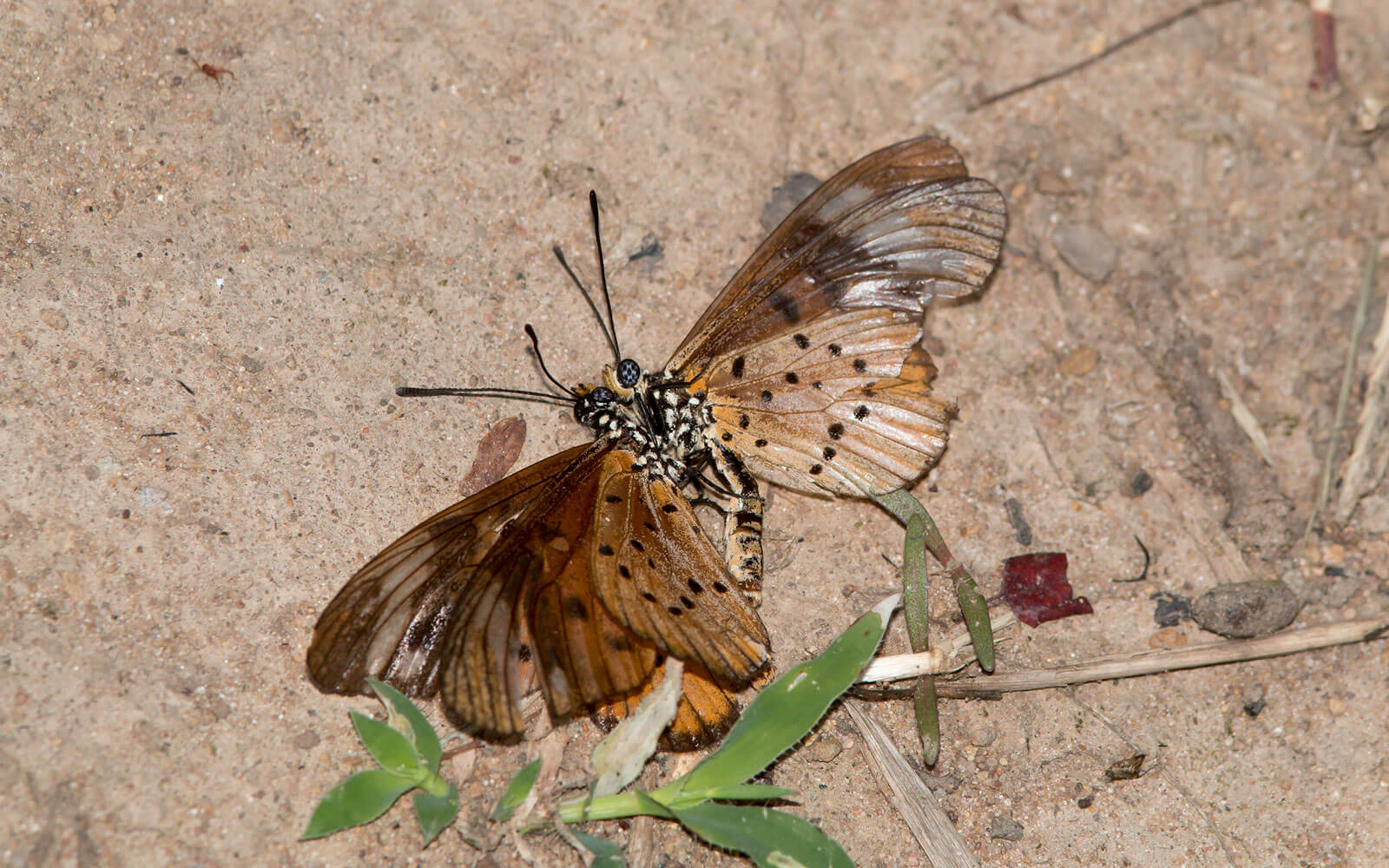
A male White-barred Telchinia, Telchinia encedon, forcibly mating a female
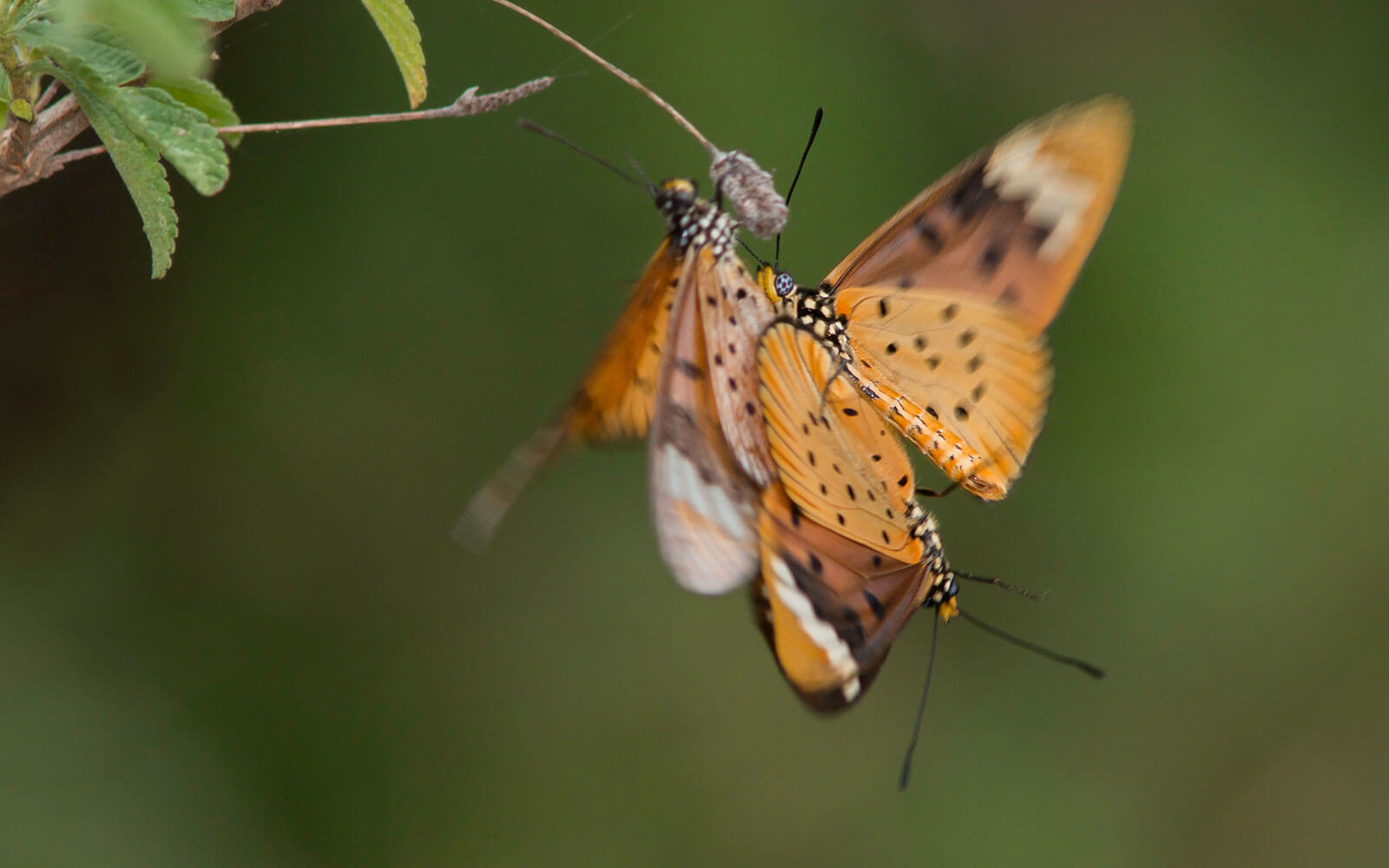
This is a mating pair of White-barred Telchinias that has attracted another male who is trying to ‘get in on the action’!
The subfamily Heliconiinae has several species whose males can be particularly violent towards the females. The male above dropped onto a passing female with an audible ‘thwack’ and wrestled her to the ground, during which he forcibly mated with her.
During the act of mating other males may be attracted. It’s not only Telchinias that do this. ‘Blues’ do it as well.
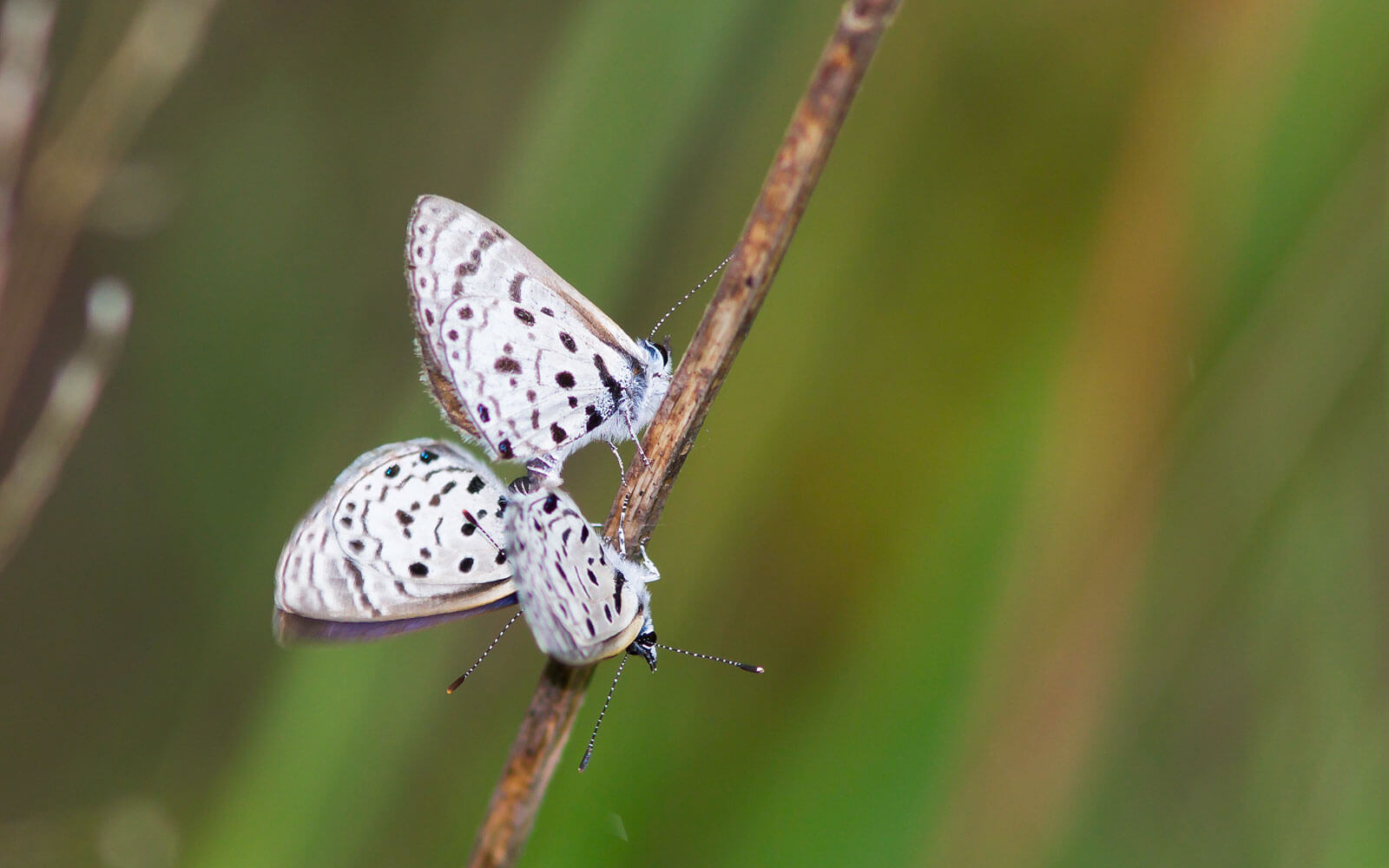
A mating pair of Black-bordered Babul Blues Azanus moriqua with a second male interfering with proceedings
The ‘tail-to-tail’ posture is very common in all insects including butterflies and moths. Quite often you will see a mating pair of butterflies in flight with one partner dangling from the other – and there may be at least one other male fluttering around them. Sometimes there’s no time for pleasantries like courtship displays – the males pounce on the females when they are barely out of the pupa!
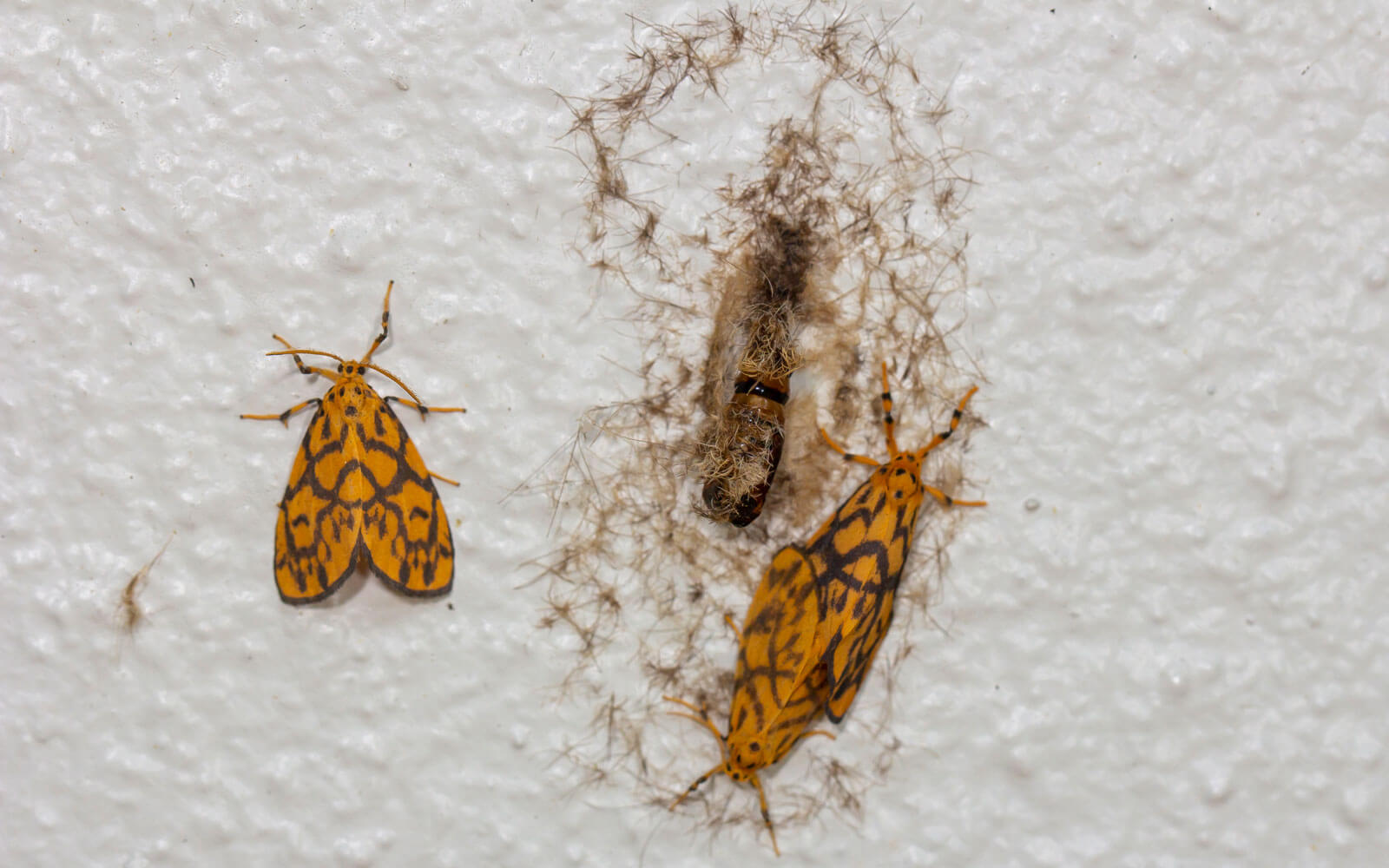
A mating pair of Crossed Footman moths next to the empty cocoon of the female
Not only has this female Crossed Footman been mated soon after emergence, but another male is also loitering nearby.
Egg laying (oviposition)
Once the mating has taken place the female needs to find a suitable place to lay her eggs. Some species’ females are very choosy and will only lay on the correct host plant for her larvae. The search behaviour for oviposition sites is quite distinctive. The female will hover slowly in the vegetation, touching plants with her feet and antennae. Those have sensitive taste and odour receptors on their surface.
When she finds the right plant, she will lay an egg. This may be a single egg inserted into a bud of the host plant or a batch of eggs that will hatch into a crowd of gregarious larvae.
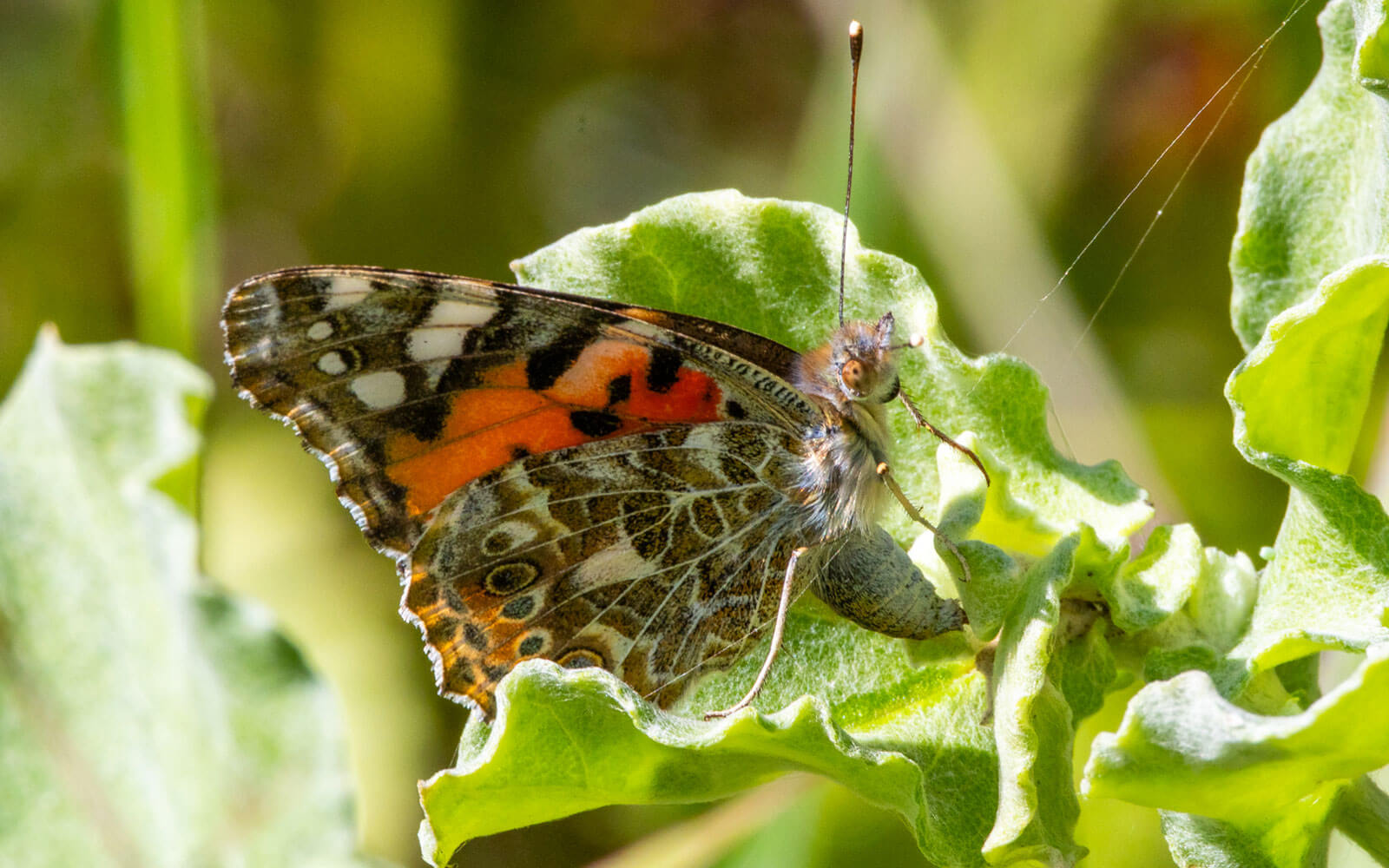
A female Painted Lady ovipositing on Helichrysum panduratum in iPhithi Nature Reserve
During a recent walk through the local iPhithi Nature Reserve I noticed a female Painted Lady butterfly hovering slowly over a patch of Helichrysum panduratum. Every so often she would quickly settle and lay an egg inside one of the plant’s growing shoots. This is one of the many species of Asteraceae this butterfly uses for its caterpillars’ food.
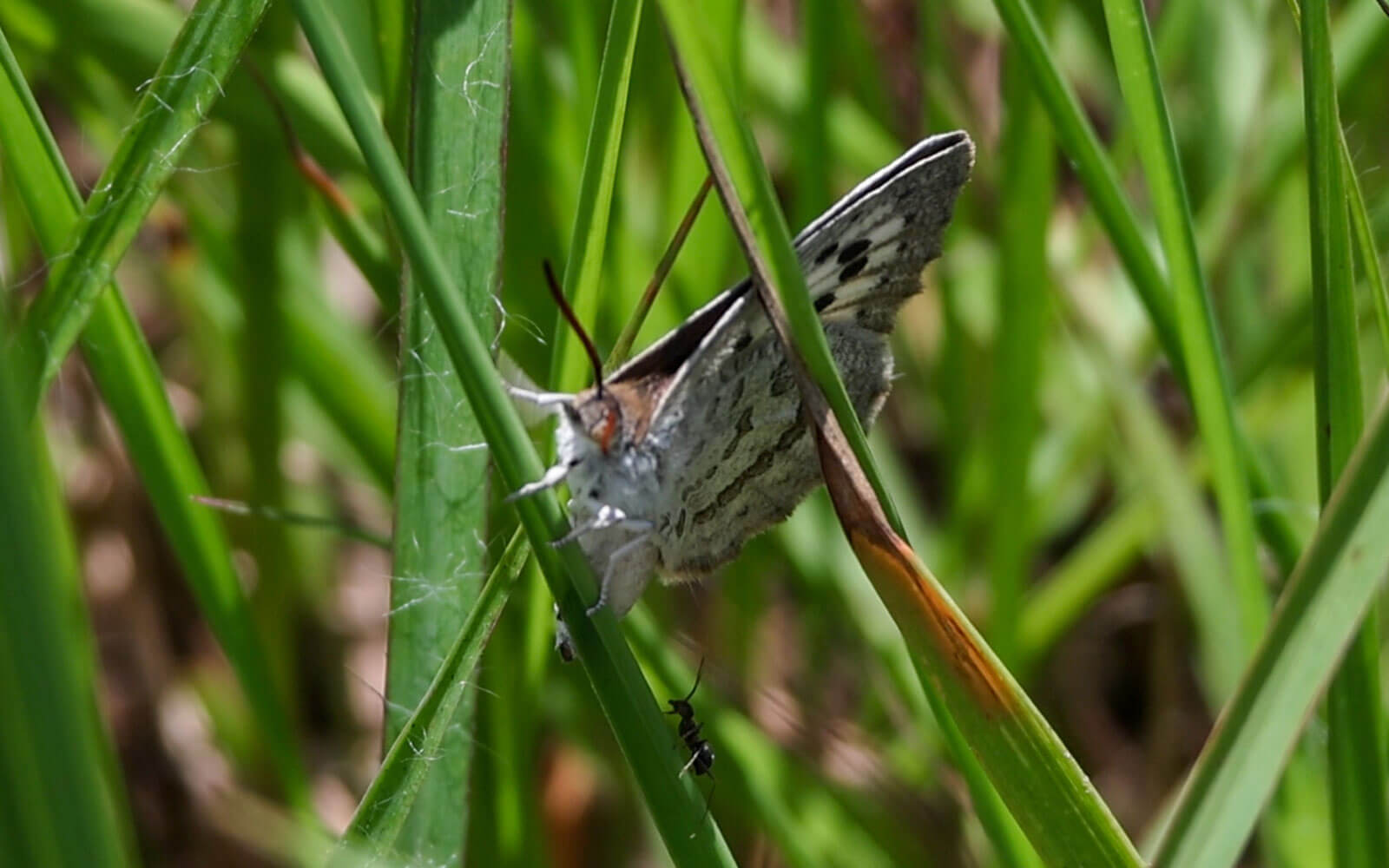
A female Basuto Skolly laying eggs on grass near her host Pugnacious ants’ nest
Some butterflies don’t need a plant to lay eggs on. The Basuto Skolly (mentioned earlier) is completely non-plant eating. The young larvae are carnivorous and feed on plant hopper nymphs (such as Jassids) and older ones live inside the nests of Pugnacious ants. The female butterfly will only oviposit where she can detect the ants’ odour.
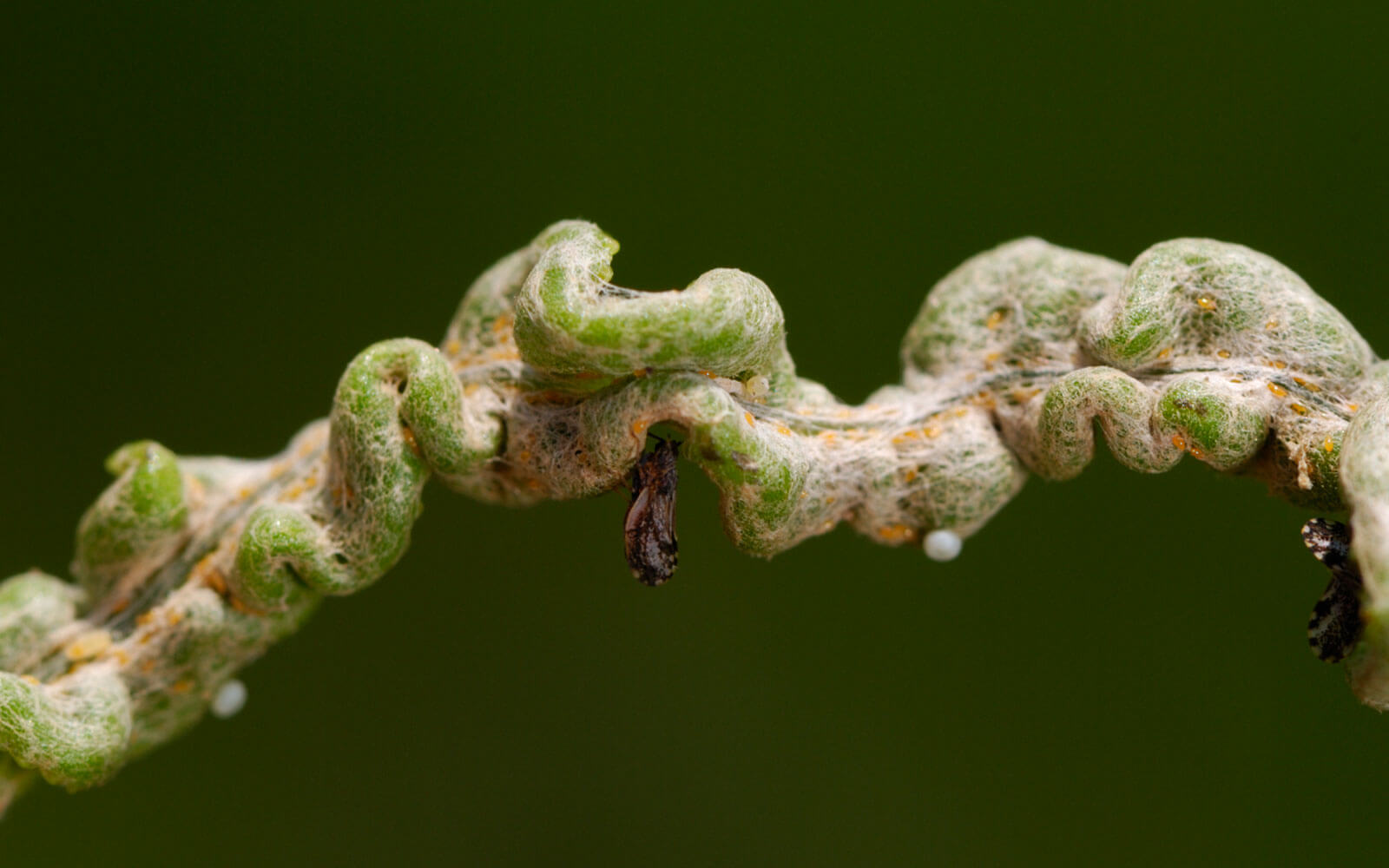
Eggs of the Basuto Skolly laid on a leaf of Hypoxis hemerocallidea infested with Jassid nymphs
This African star grass leaf has several little white Basuto Skolly eggs, laid among the tiny yellow nymphs of Jassid plant hoppers. Those are the prey for the young larvae when they hatch from the eggs.
Many butterflies don’t lay single eggs; they lay them en masse in ‘rafts’. The larvae are gregarious on emergence.
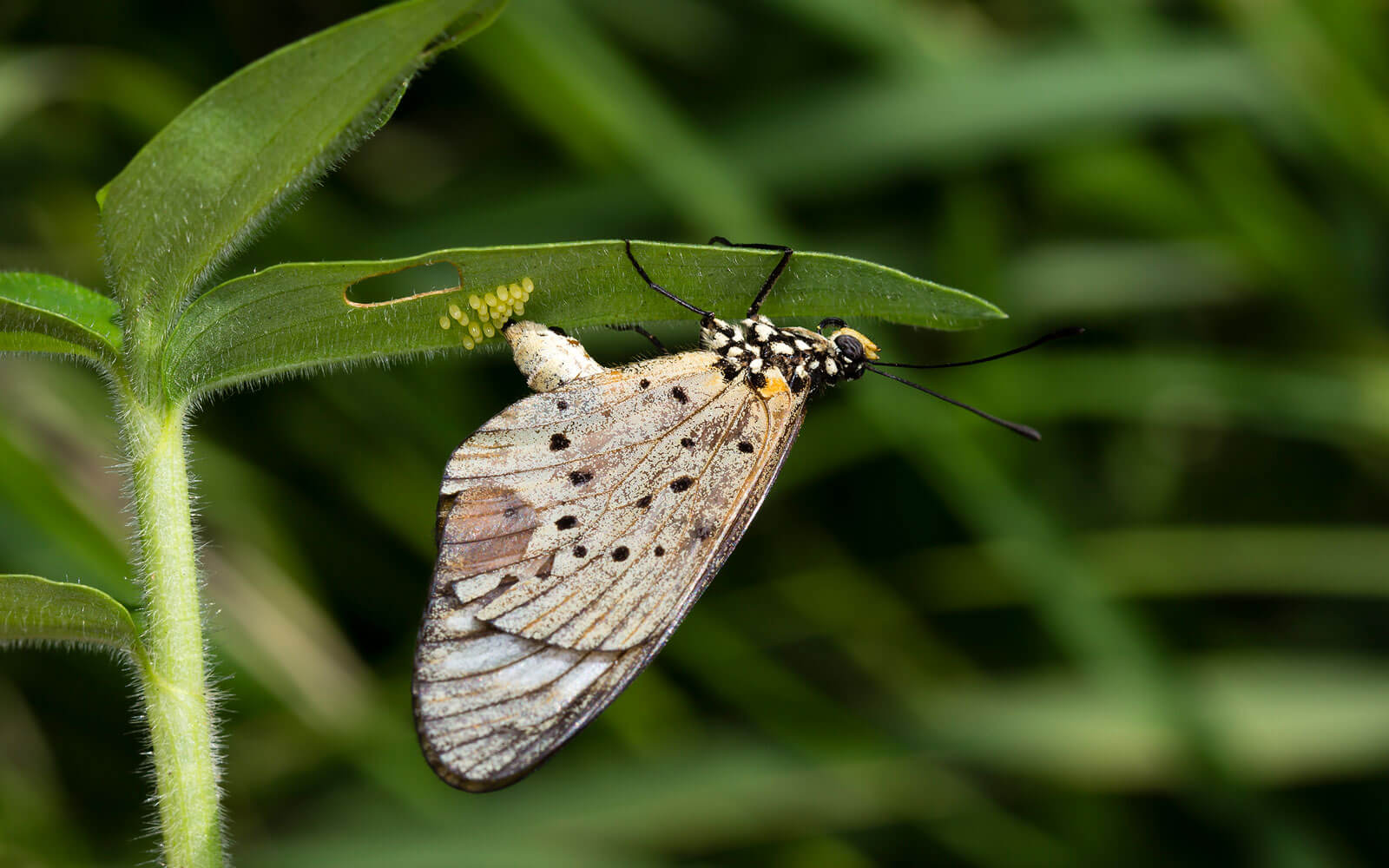
A female White-barred Telchinia laying a batch of eggs on her larval host plant, Benghal dayflower Commelina benghalensis.
Many of the subfamily Heliconiinae, especially the Acraeas and Telchinias, lay their eggs in rafts. This gives the young larvae a greater chance of success because only a small percentage would be affected by predators.
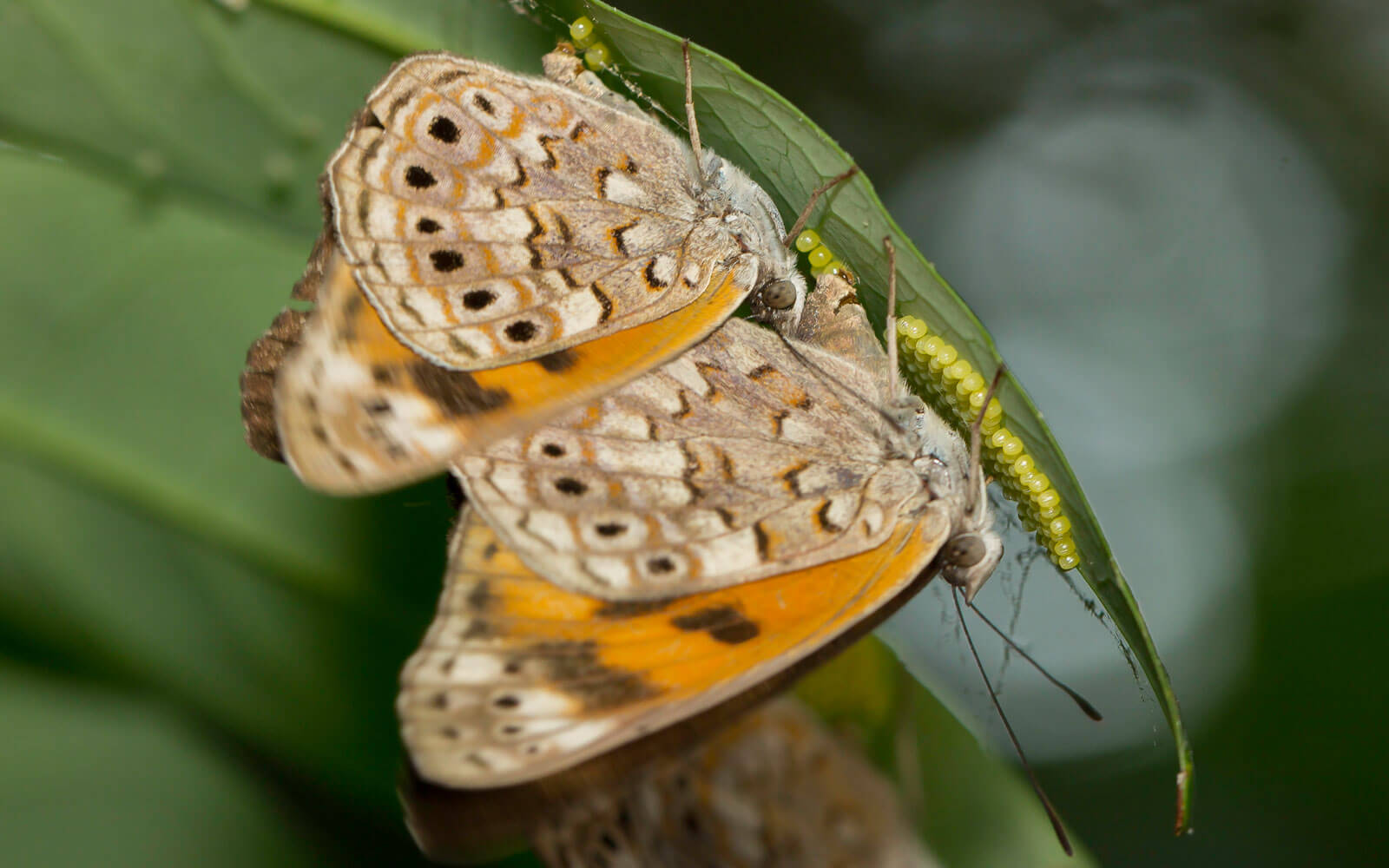
Boisduval’s Tree Nymph females laying eggs on the host plant, Sclerocroton integerrimus, the Duiker-berry.
The Boisduval’s Tree Nymph, Sevenia boisduvali boisduvali, lays rafts of eggs that hatch into large numbers of gregarious caterpillars. The female butterflies are also gregarious and get into a ‘laying frenzy’ with several individuals laying egg rafts next to one another. This can result in a large Duiker-berry tree becoming completely defoliated in a matter of weeks. This does the tree no harm; the pruning stimulates fresh growth and the caterpillars’ dung helps fertilise it!
The incredible diversity of lepidopteran reproductive behaviour
This short article can only scratch the surface of butterfly and moth reproductive behaviour. There are thousands of species of Lepidoptera in dozens of families, using hundreds of different food sources, not all of them vegetable. The diversity is immense. Only a few of them come to our notice in their young stages, usually because their caterpillars are regarded as ‘pests’. These occur largely because they take advantage of our habit of planting vegetable monocultures. The females don’t set out deliberately to conflict with our priorities; they are only doing what comes naturally – smelling out host plants and laying eggs on them. The vast majority are very good at hiding their young and you might never know they’re there until you see a brightly coloured adult flying around!

Steve Woodhall is a butterfly enthusiast and photographer who began watching and collecting butterflies at an early age. He was President of the Lepidopterists’ Society of Africa for eight years, and has contributed to and authored several books, including Field Guide to Butterflies of South Africa and Gardening for Butterflies and the recent children’s book My First Book of Southern African Caterpillars. His app, Woodhall’s Butterflies of South Africa, is described as the definitive butterfly ID guide for South Africa.
Steve has been a valuable and informative informal guide on many butterfly outings and recently qualified as a formal FGASA Field Guide. He is now available to officially guide tours via his ButterflyGear business entity www.butterflygear.co.za. Steve can be contacted on +27 82 825 8450 or steve@butterflygear.co.za.